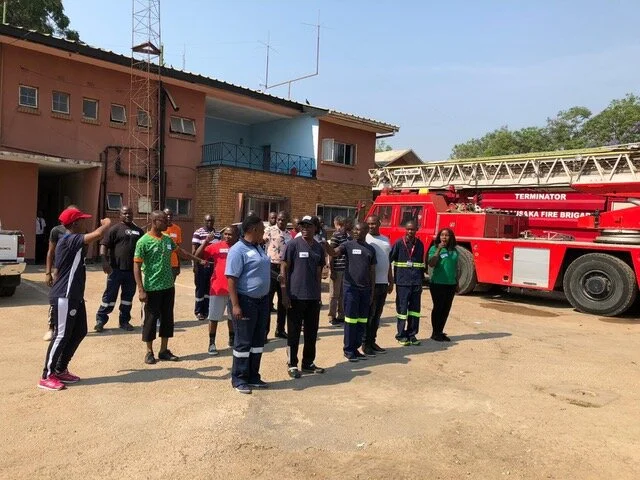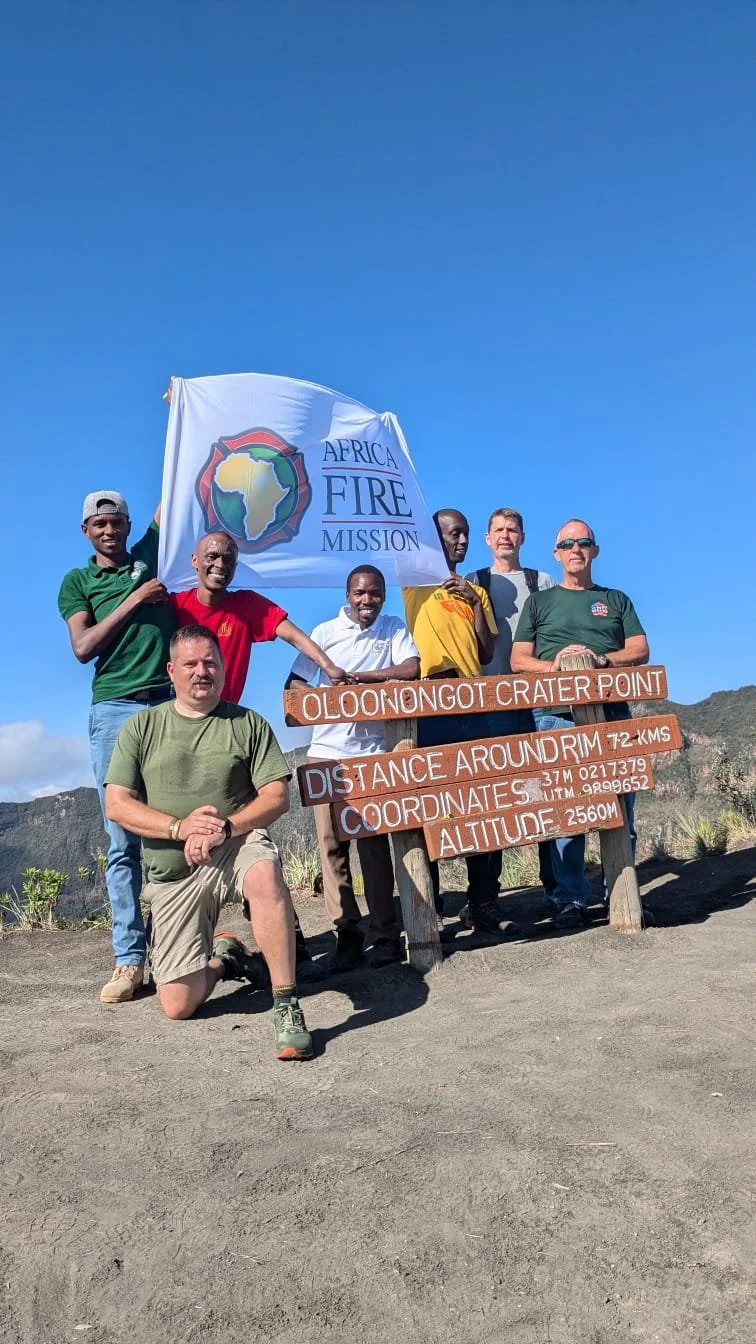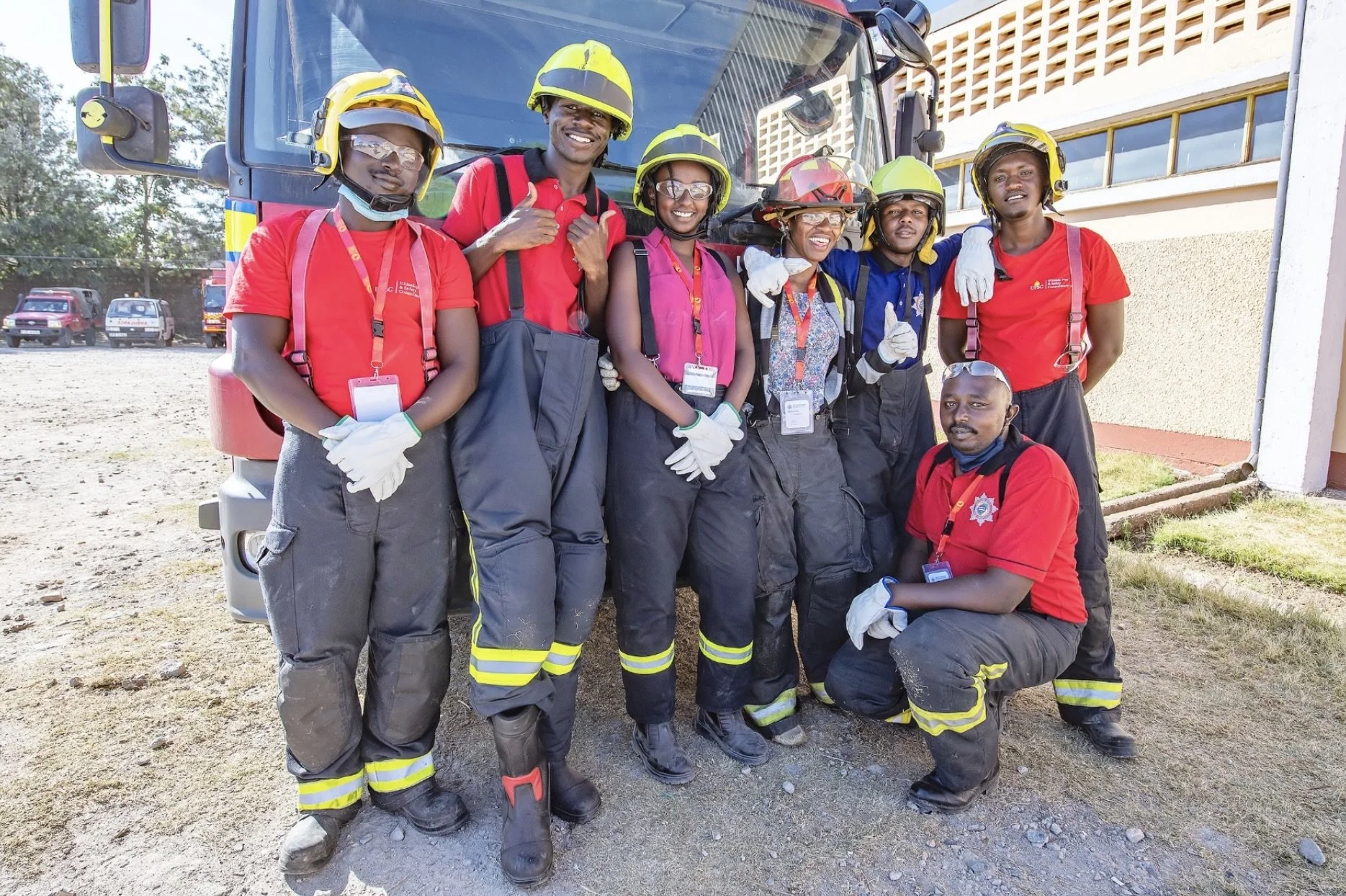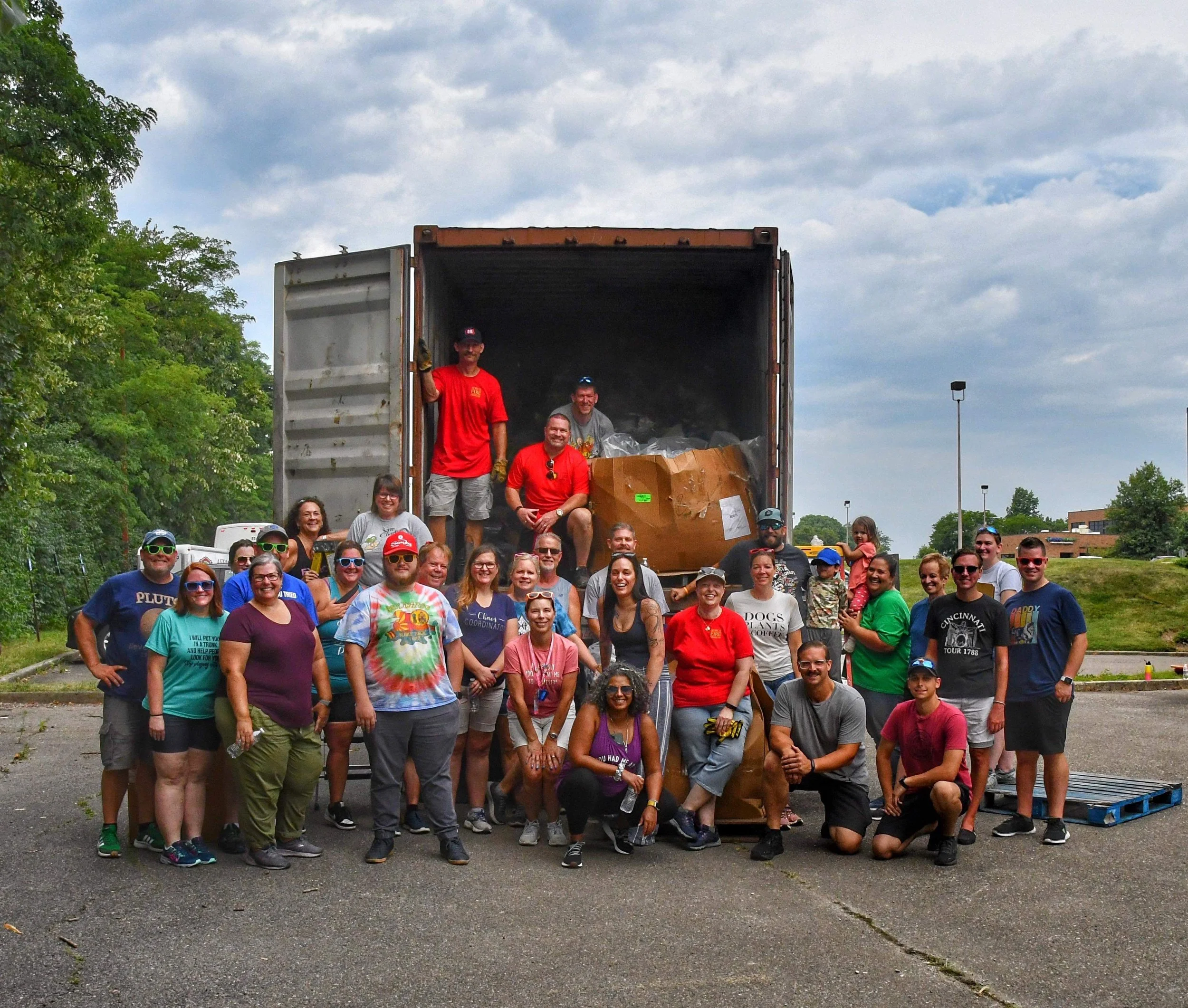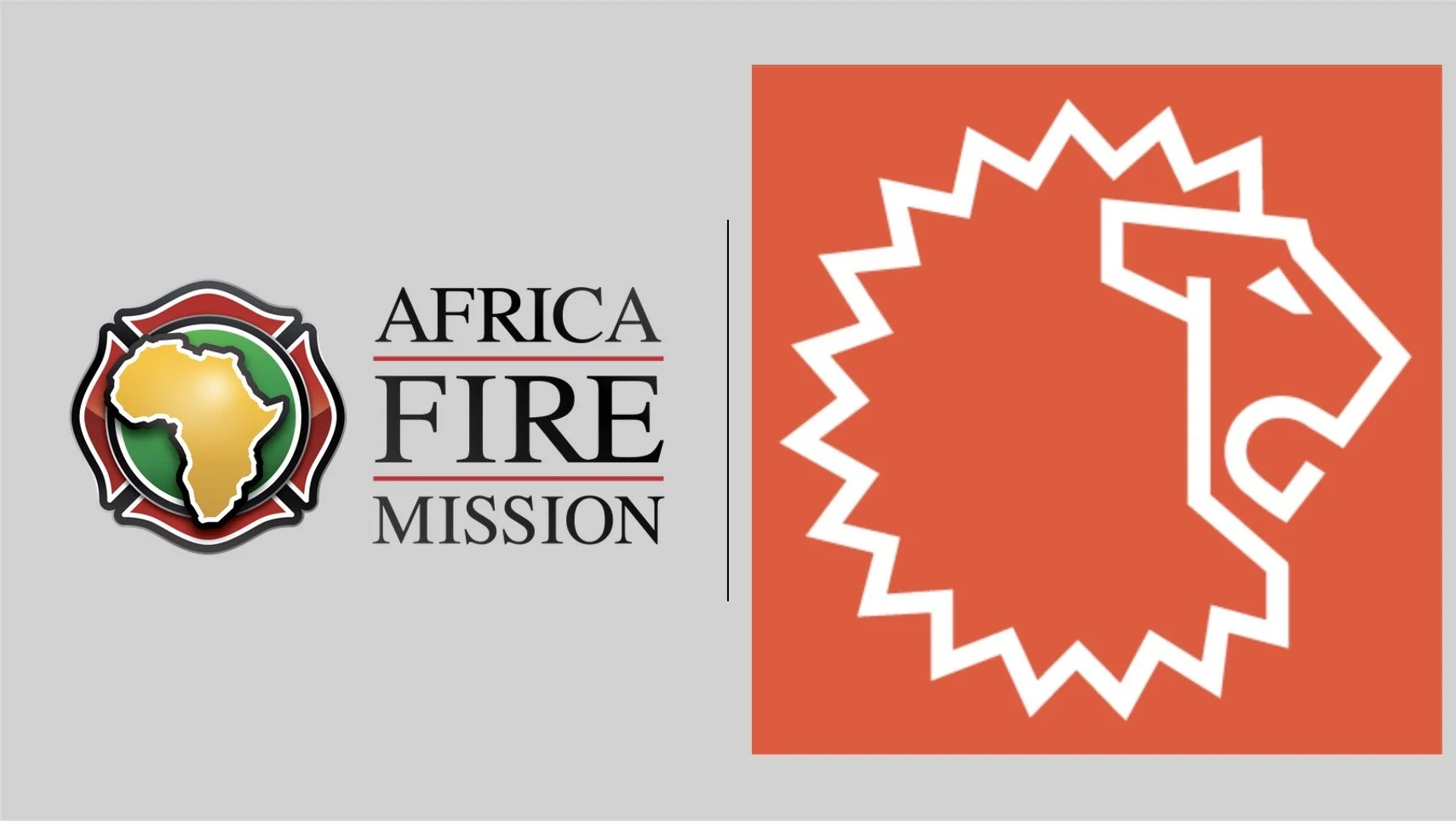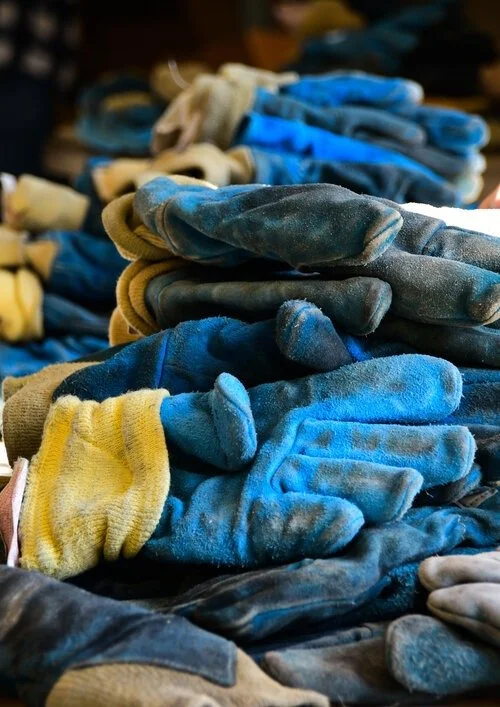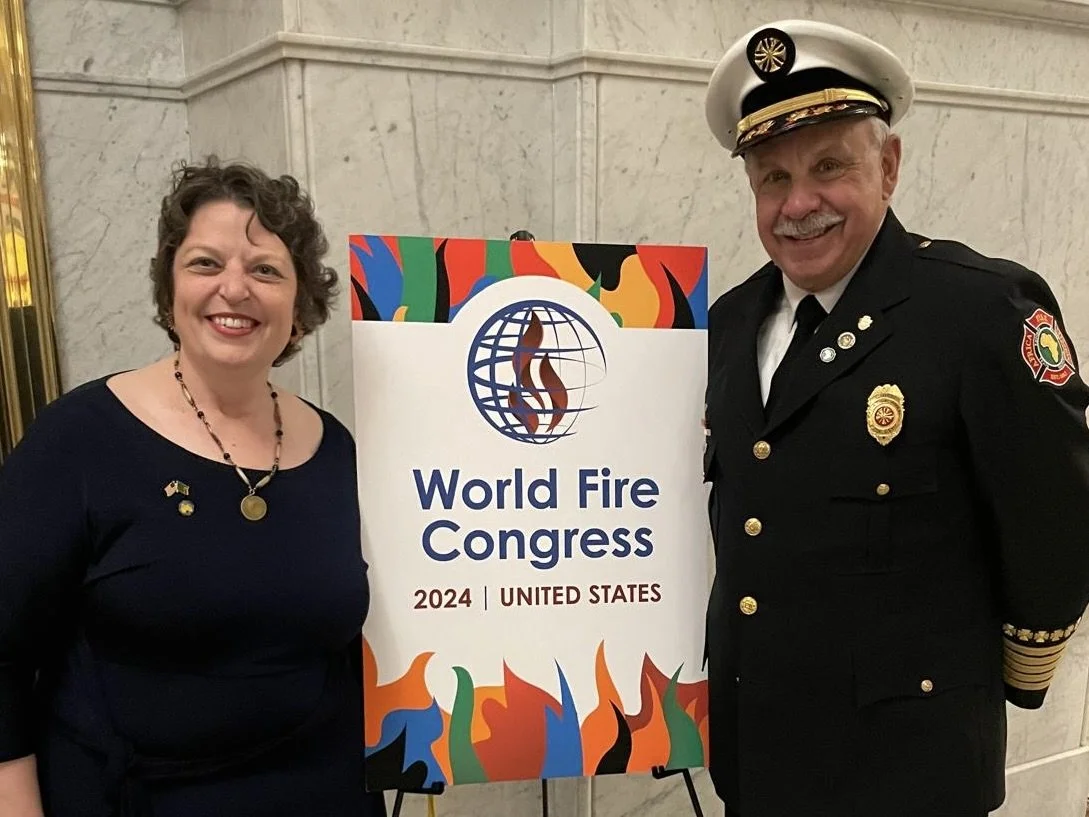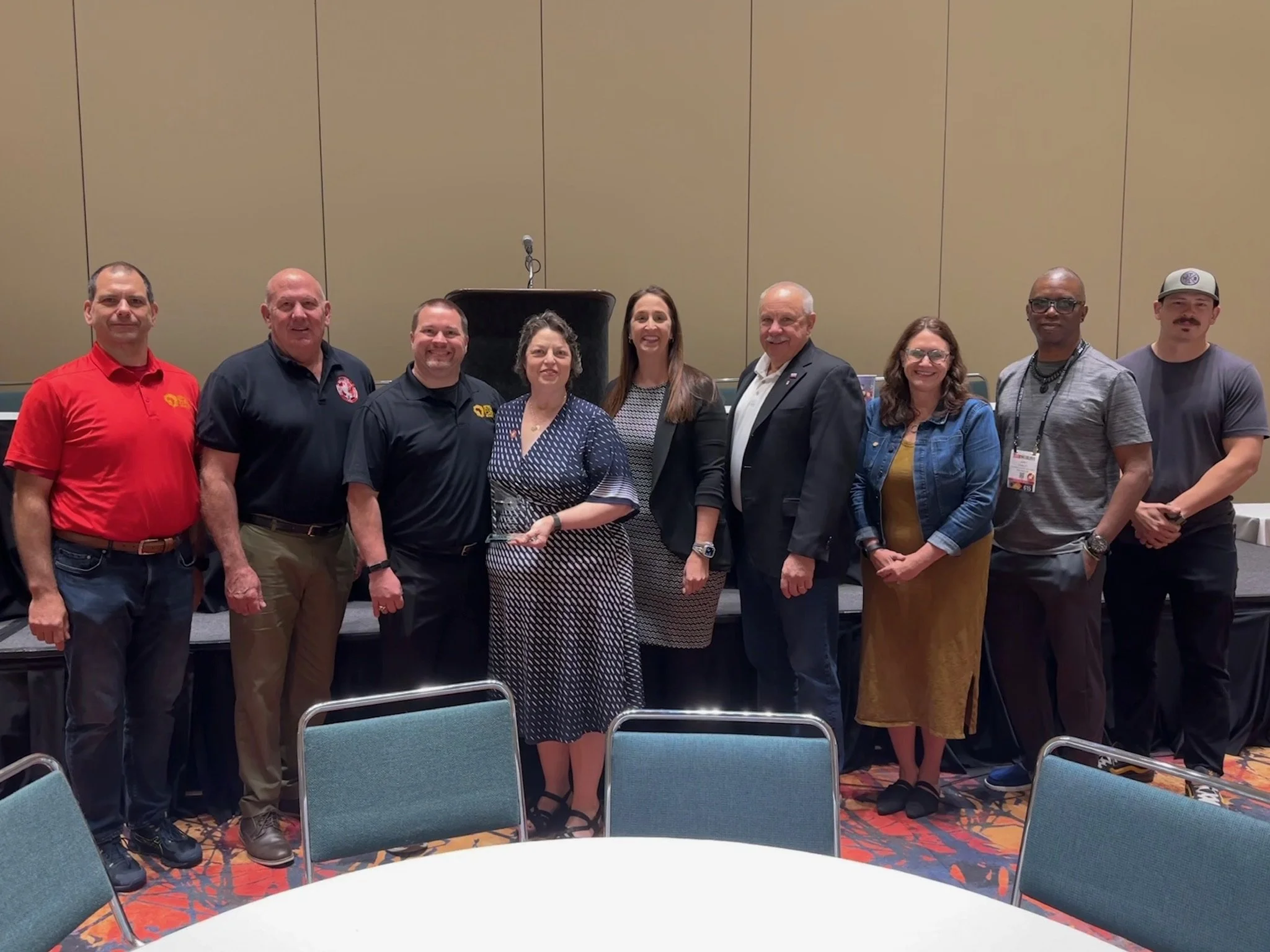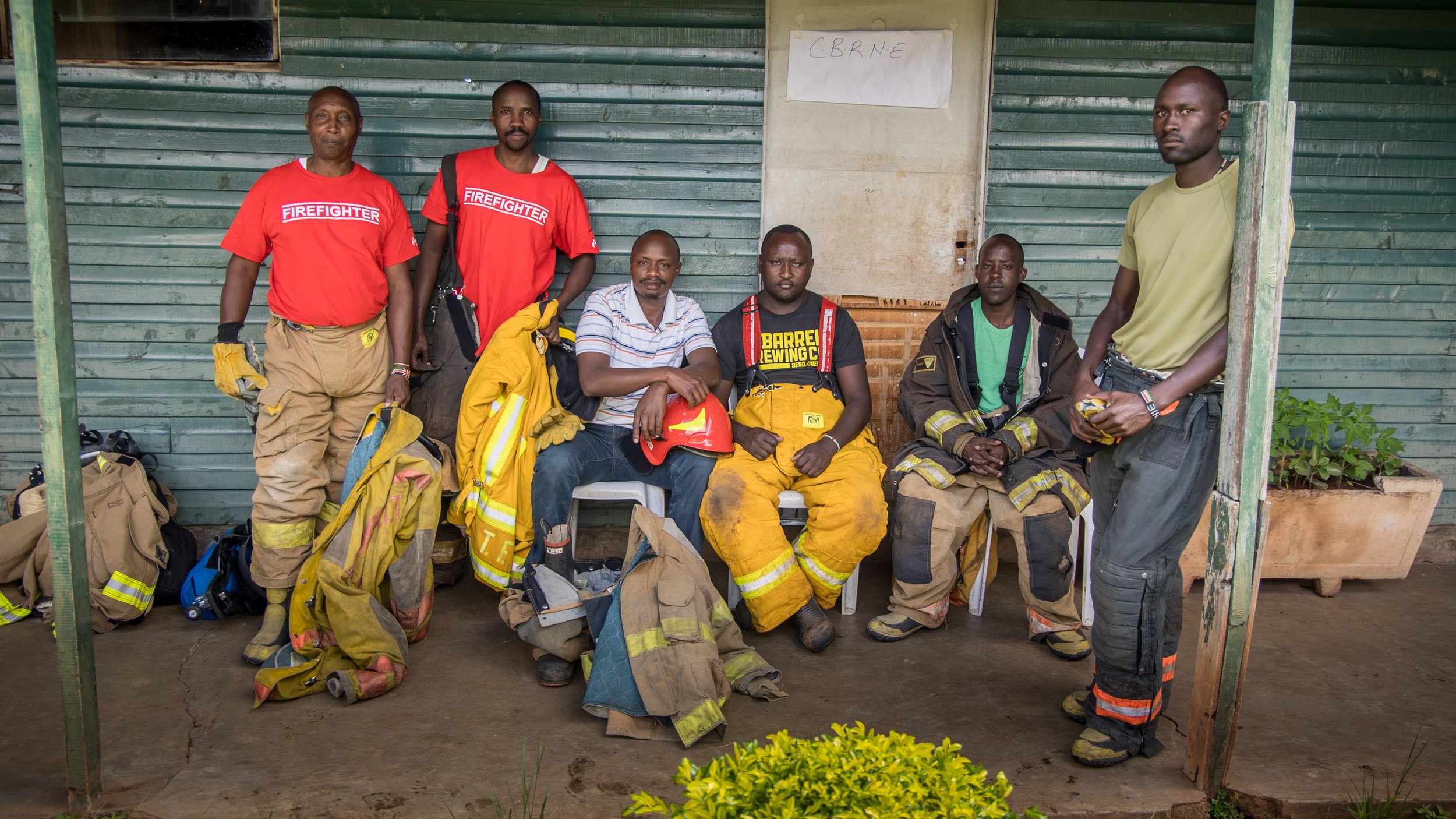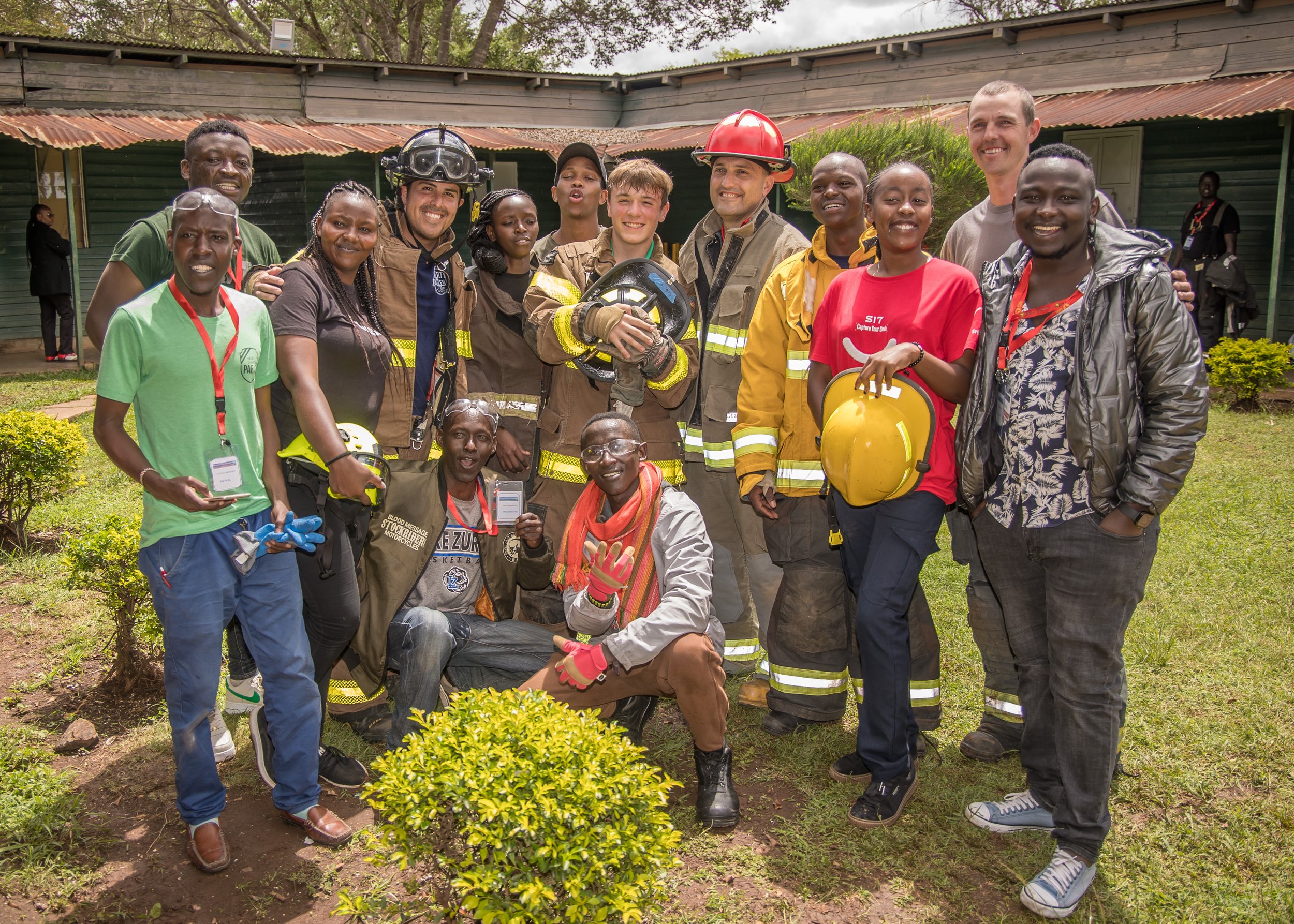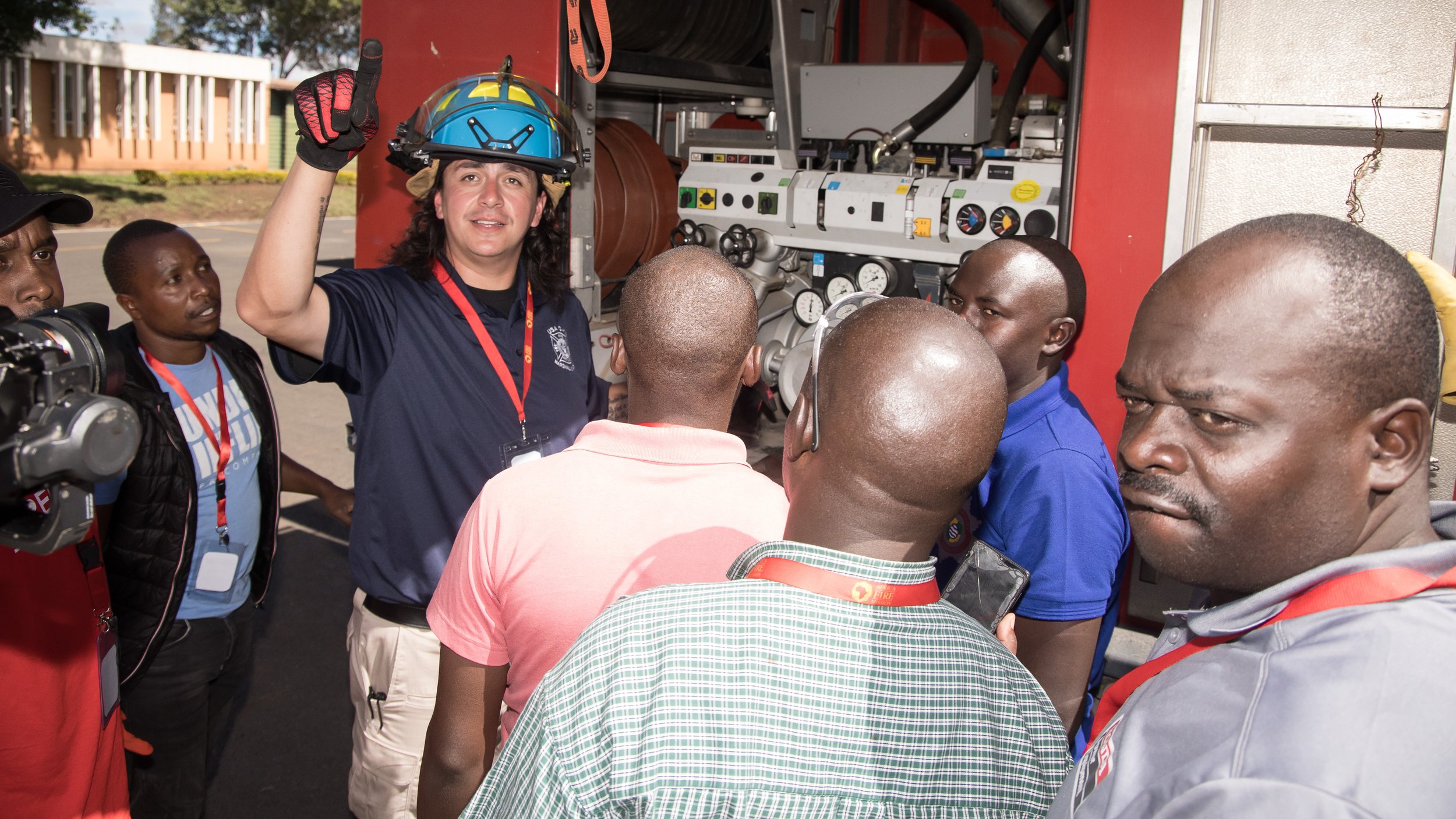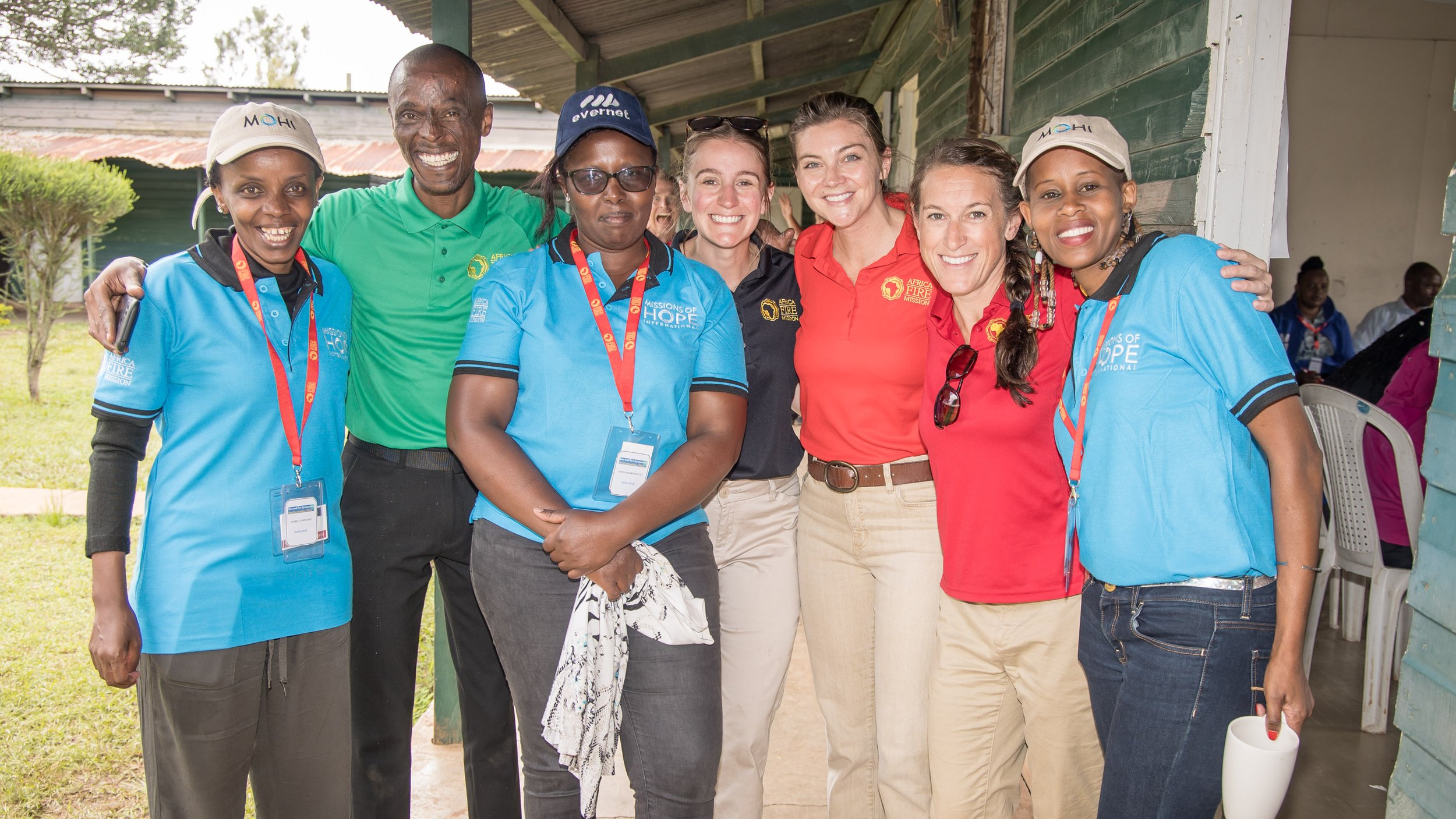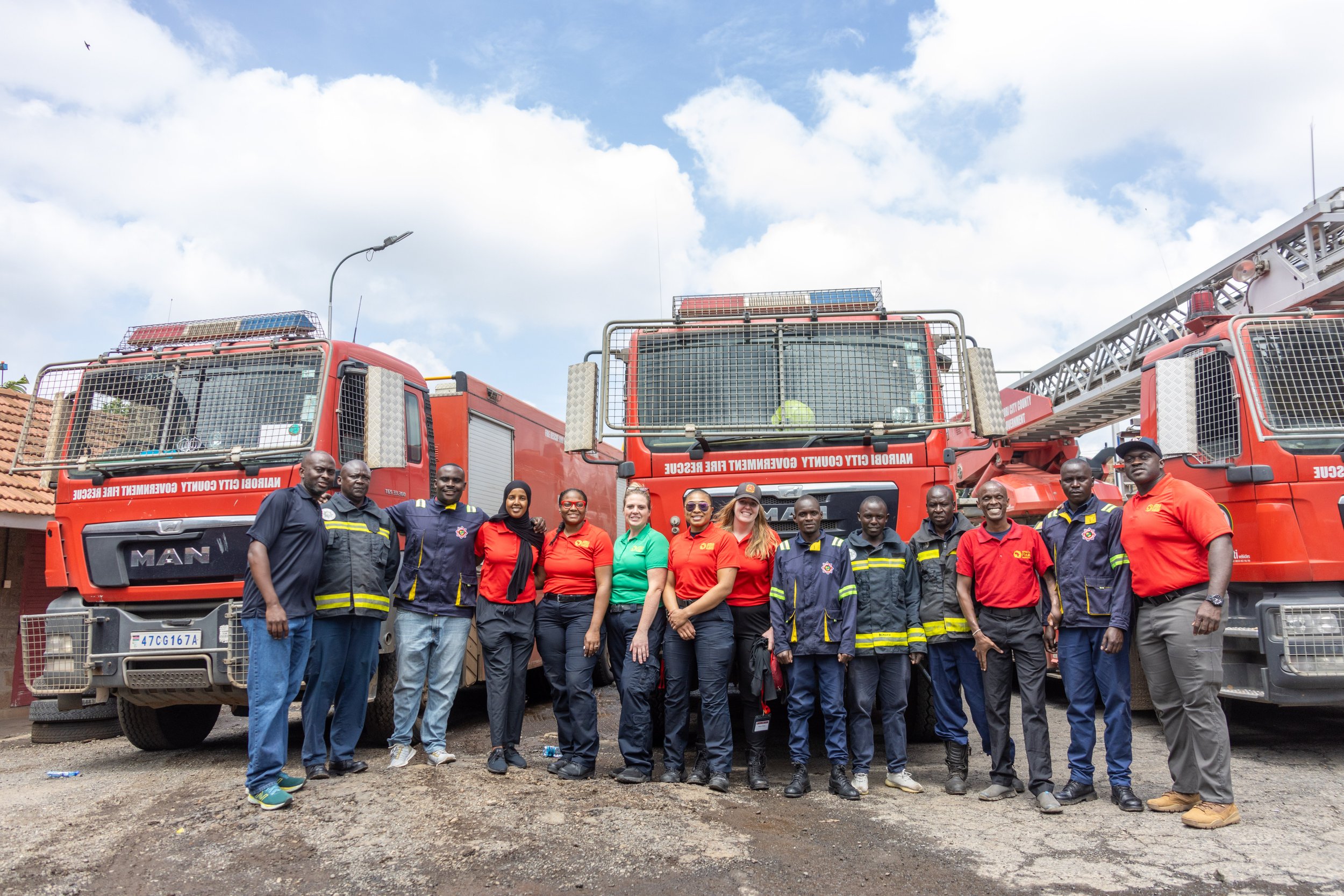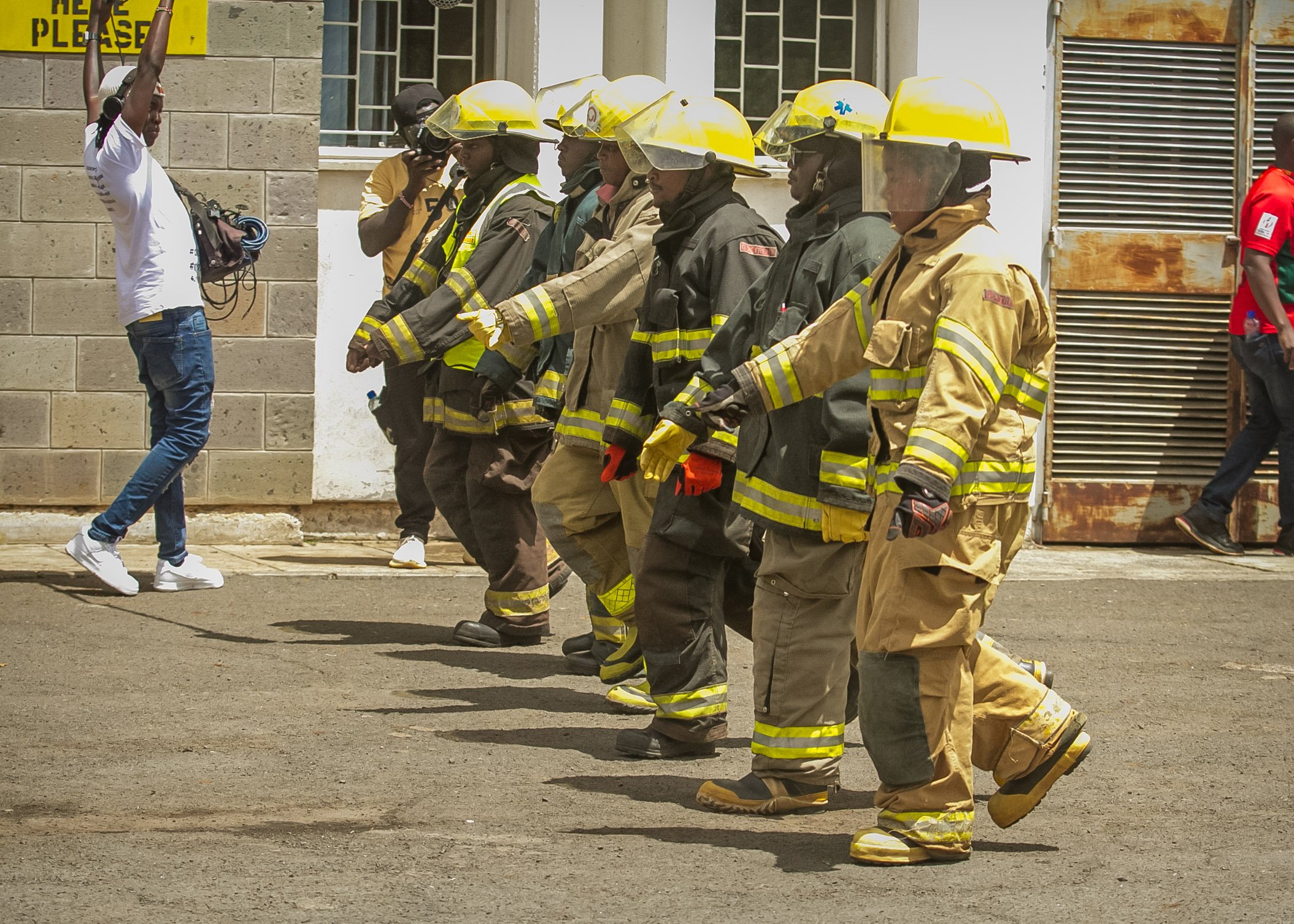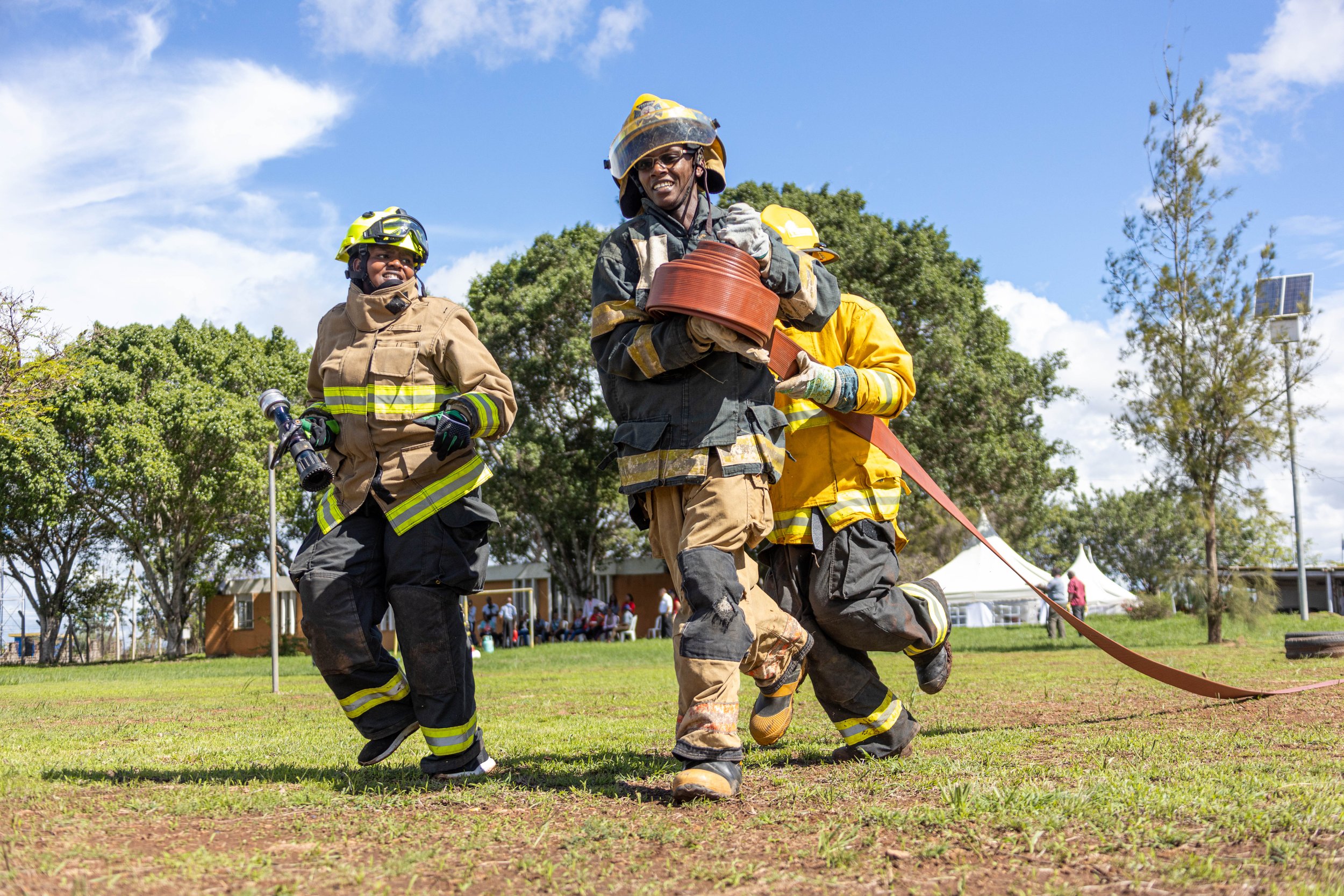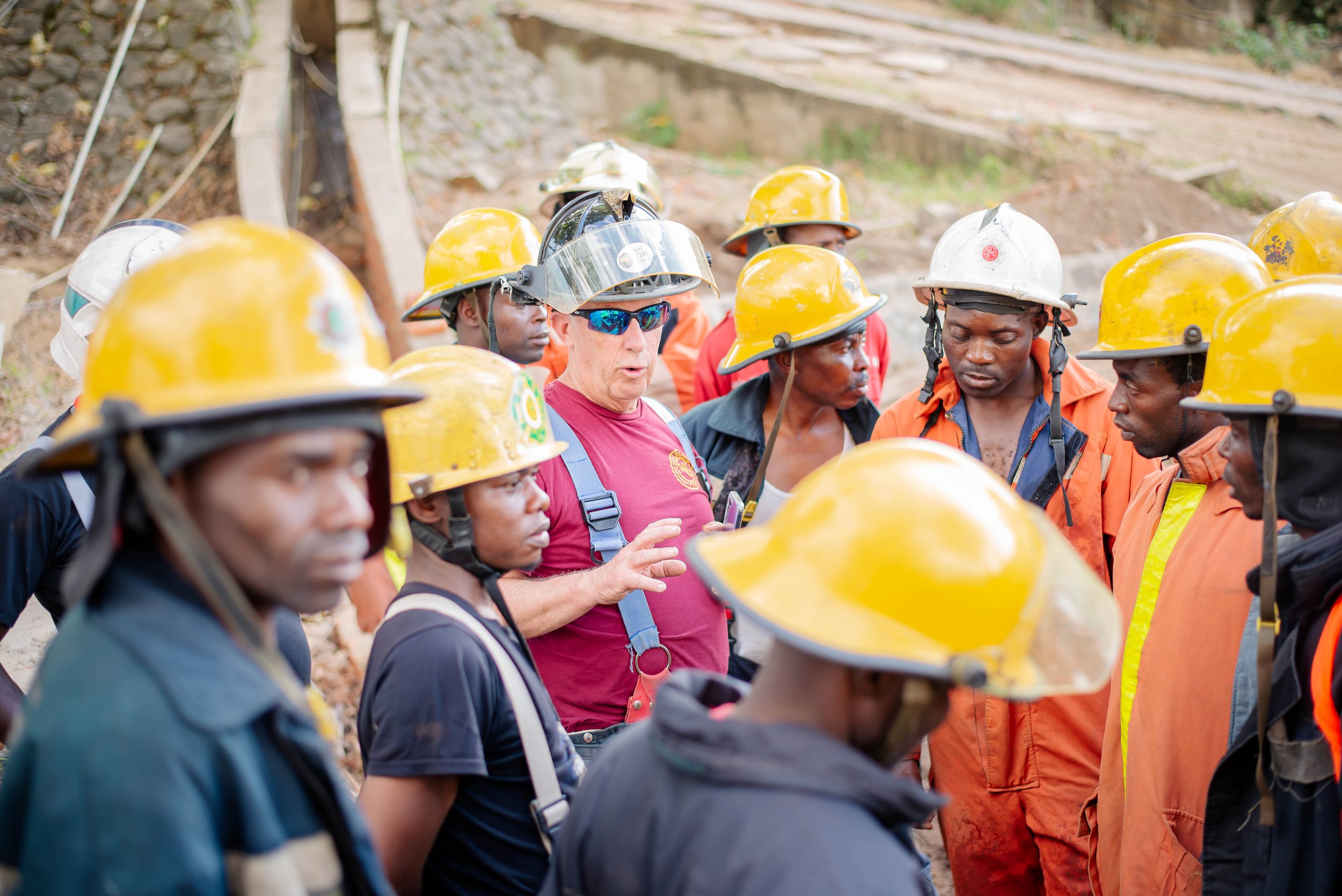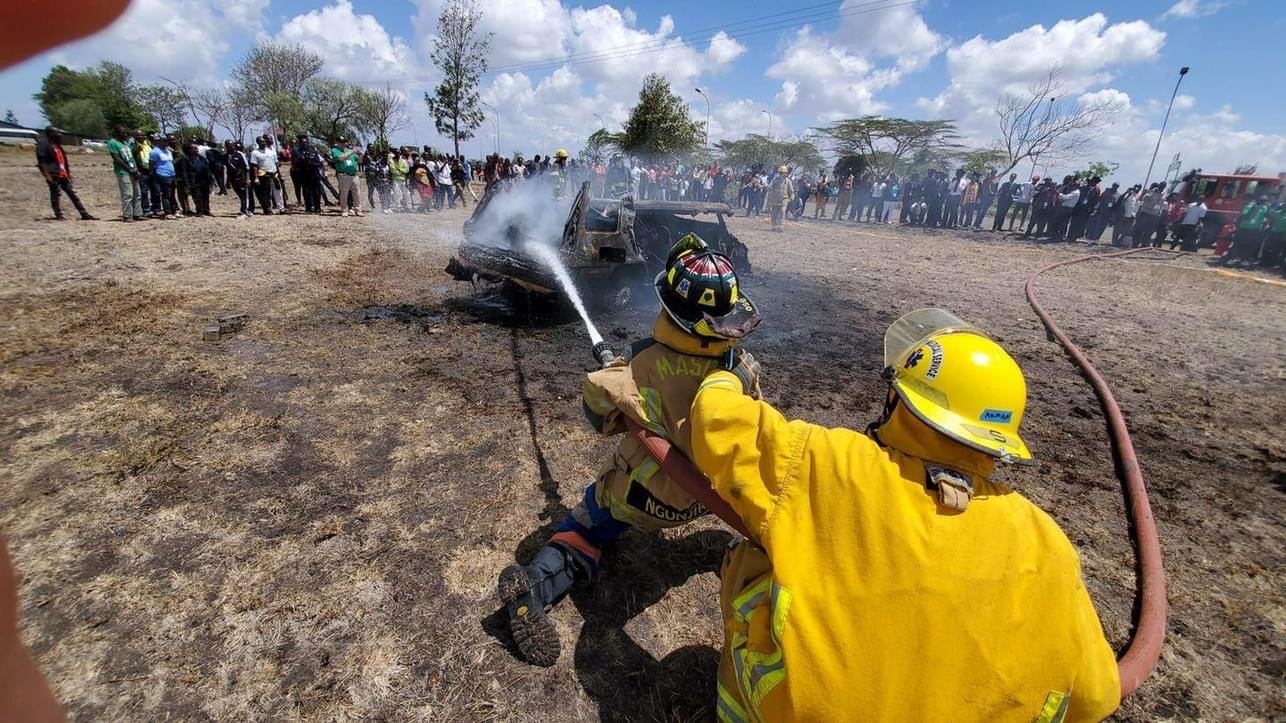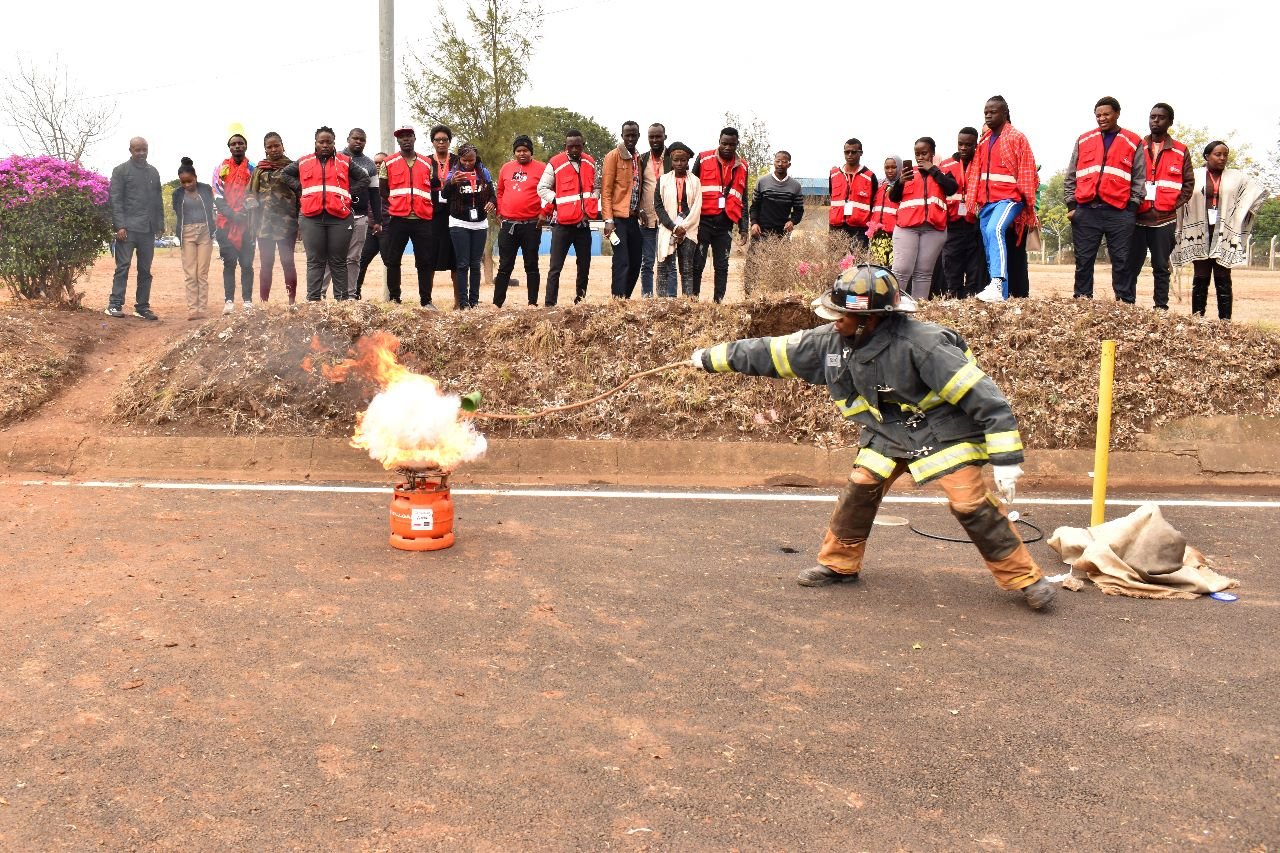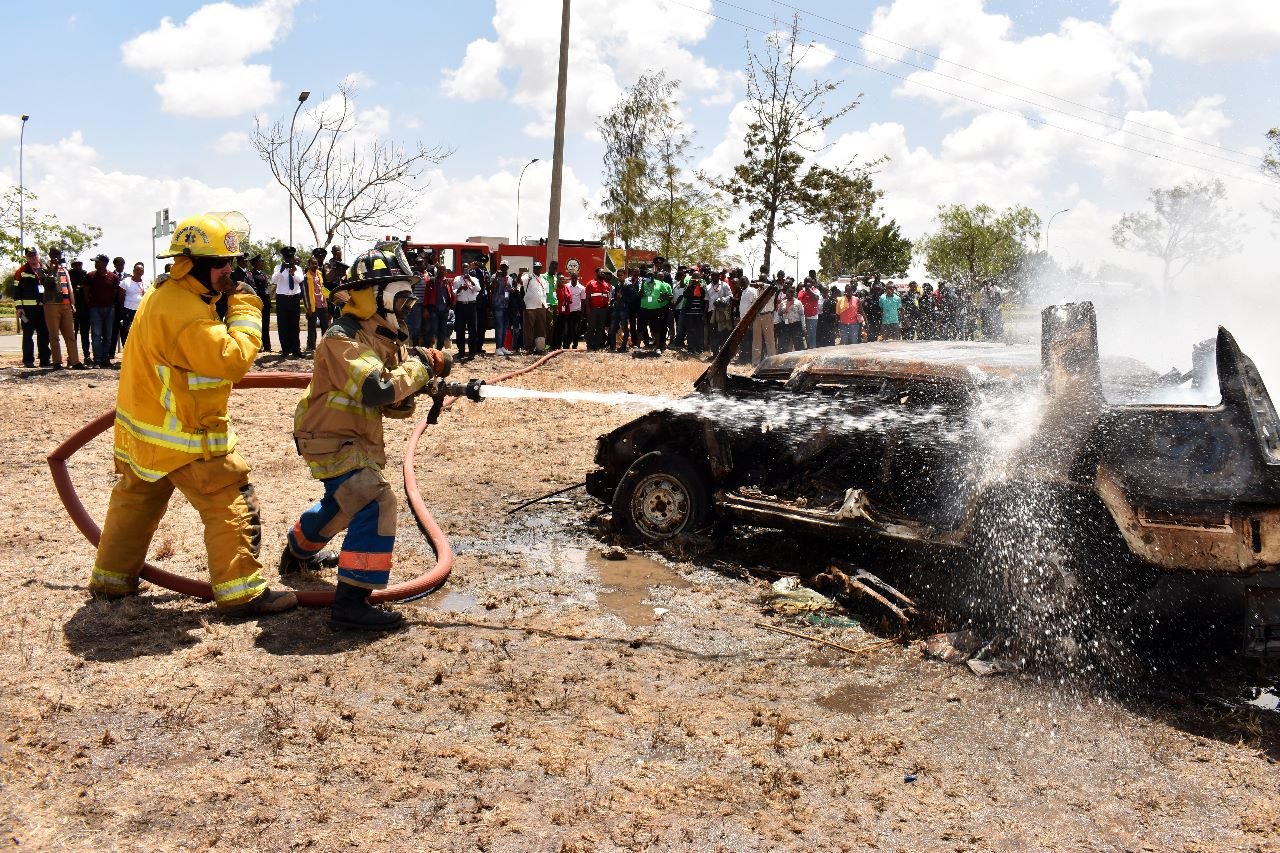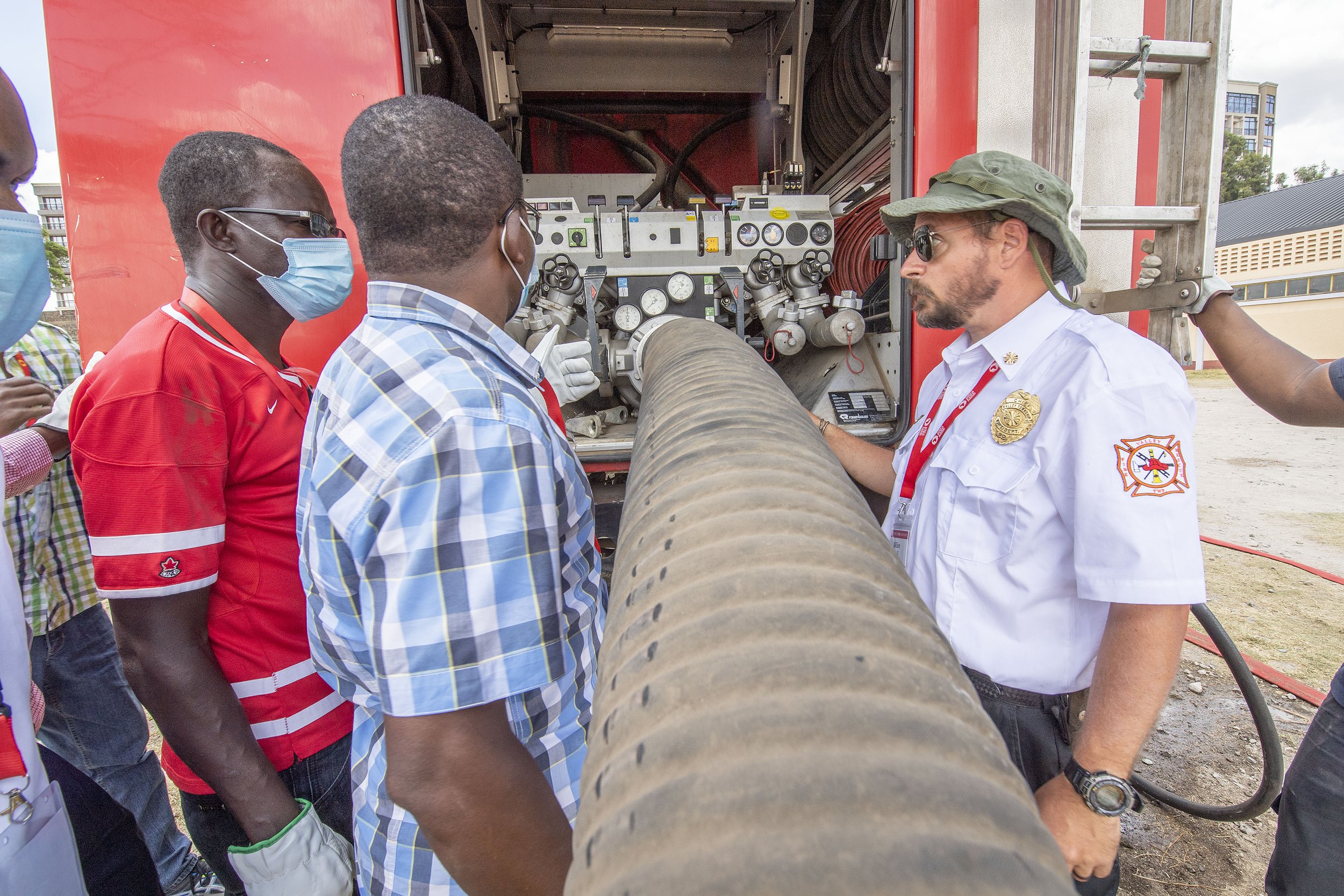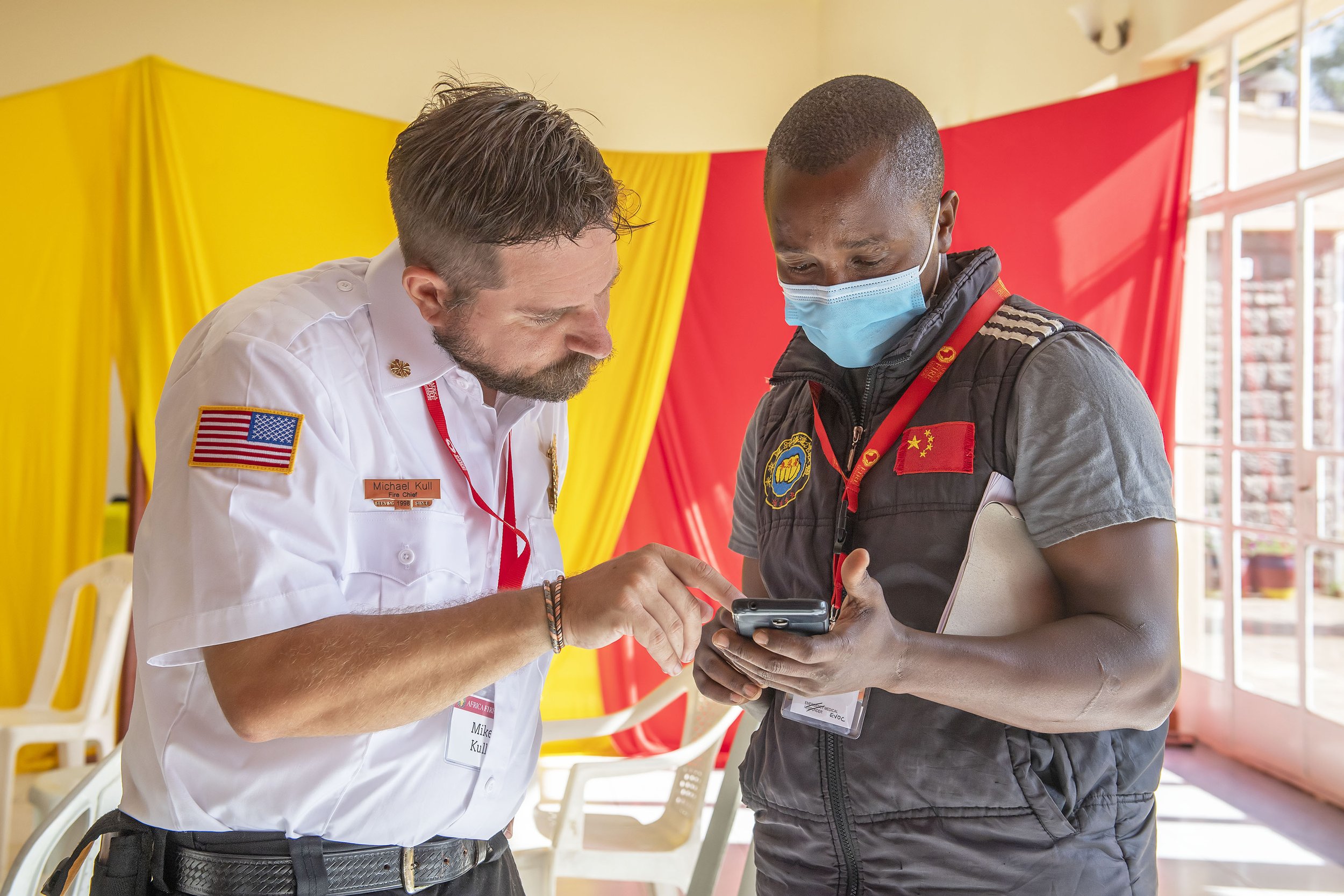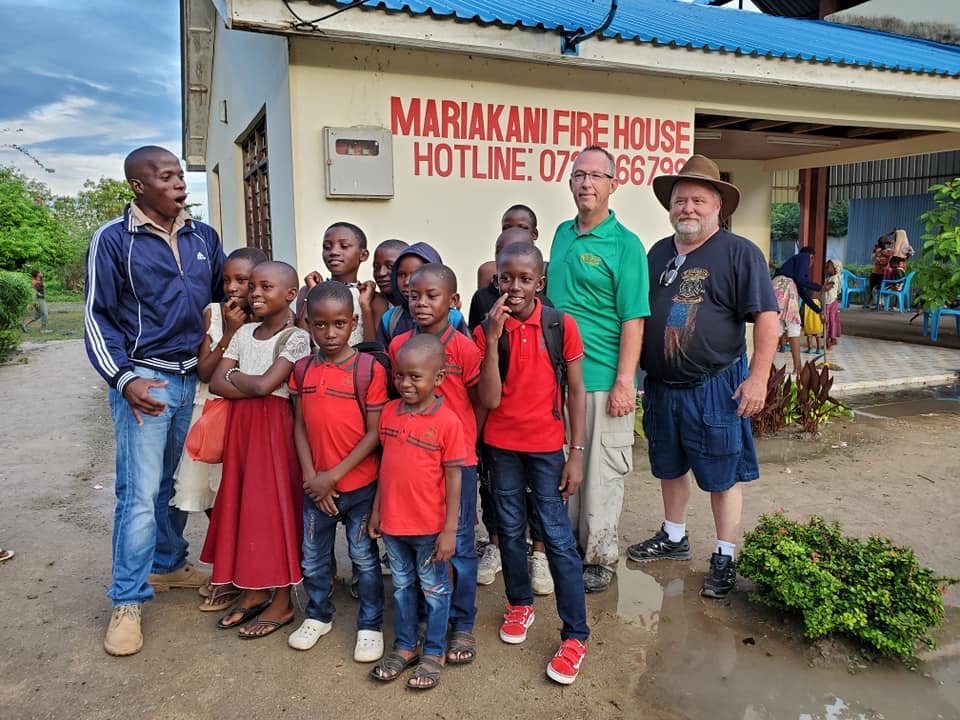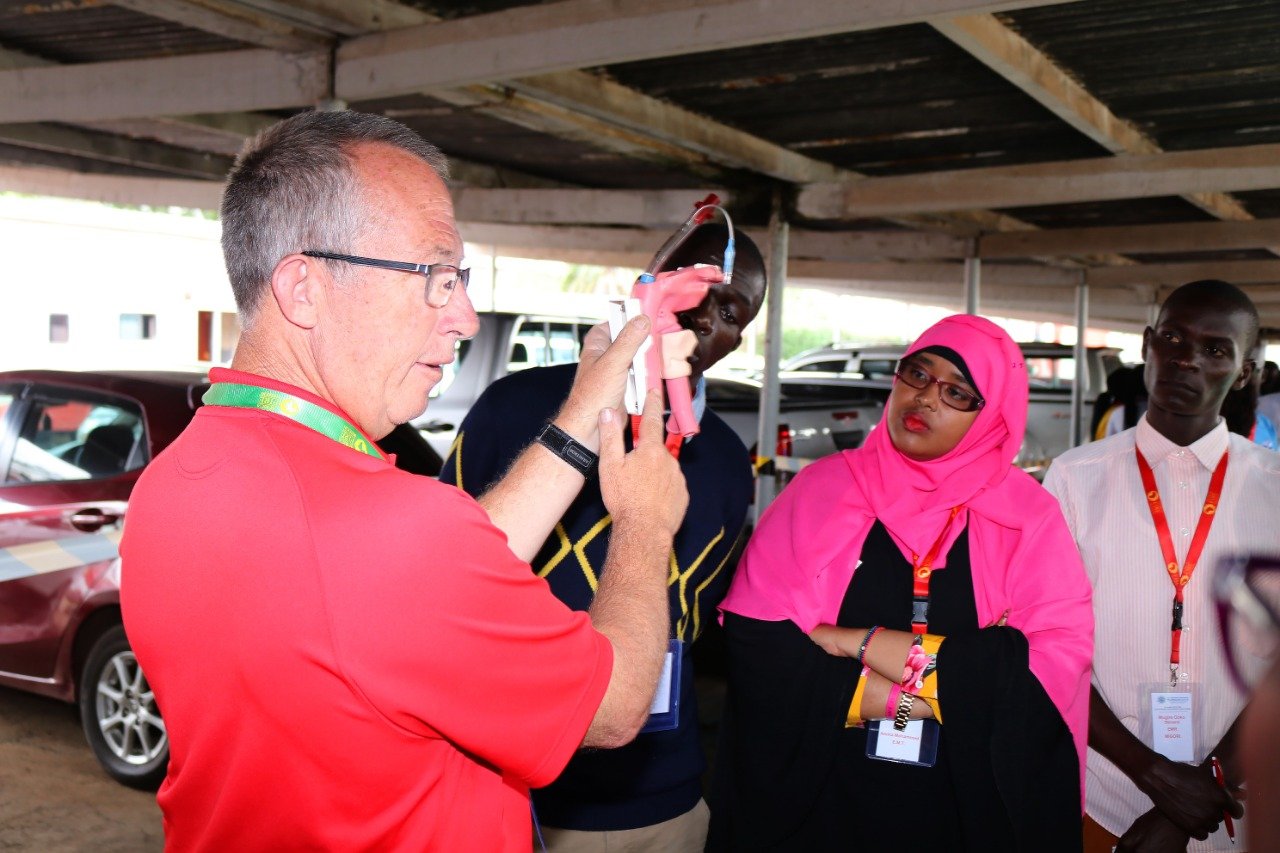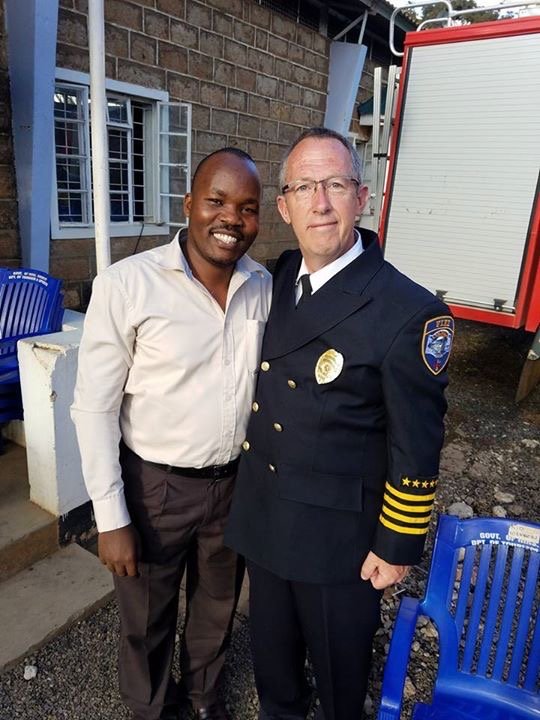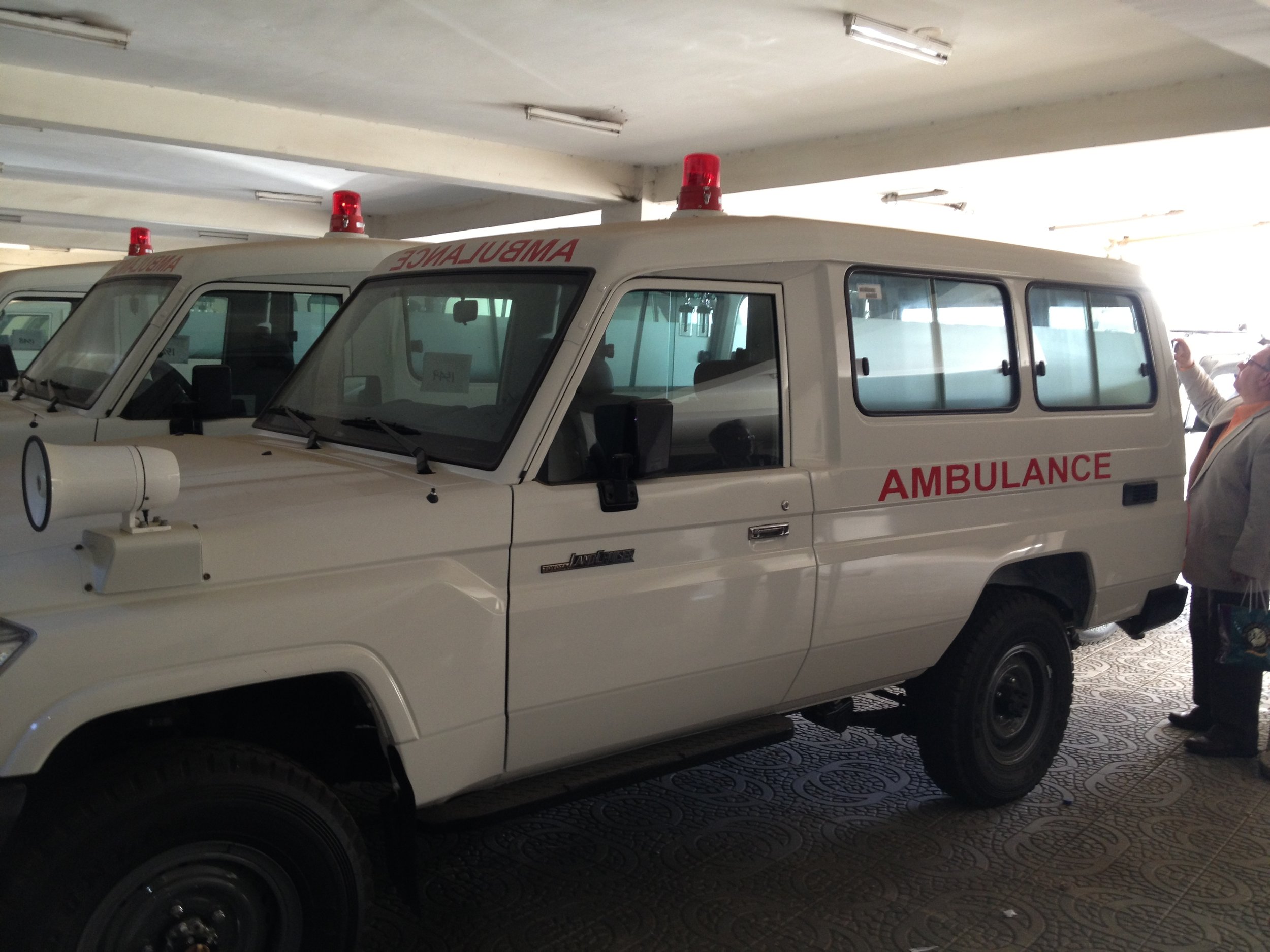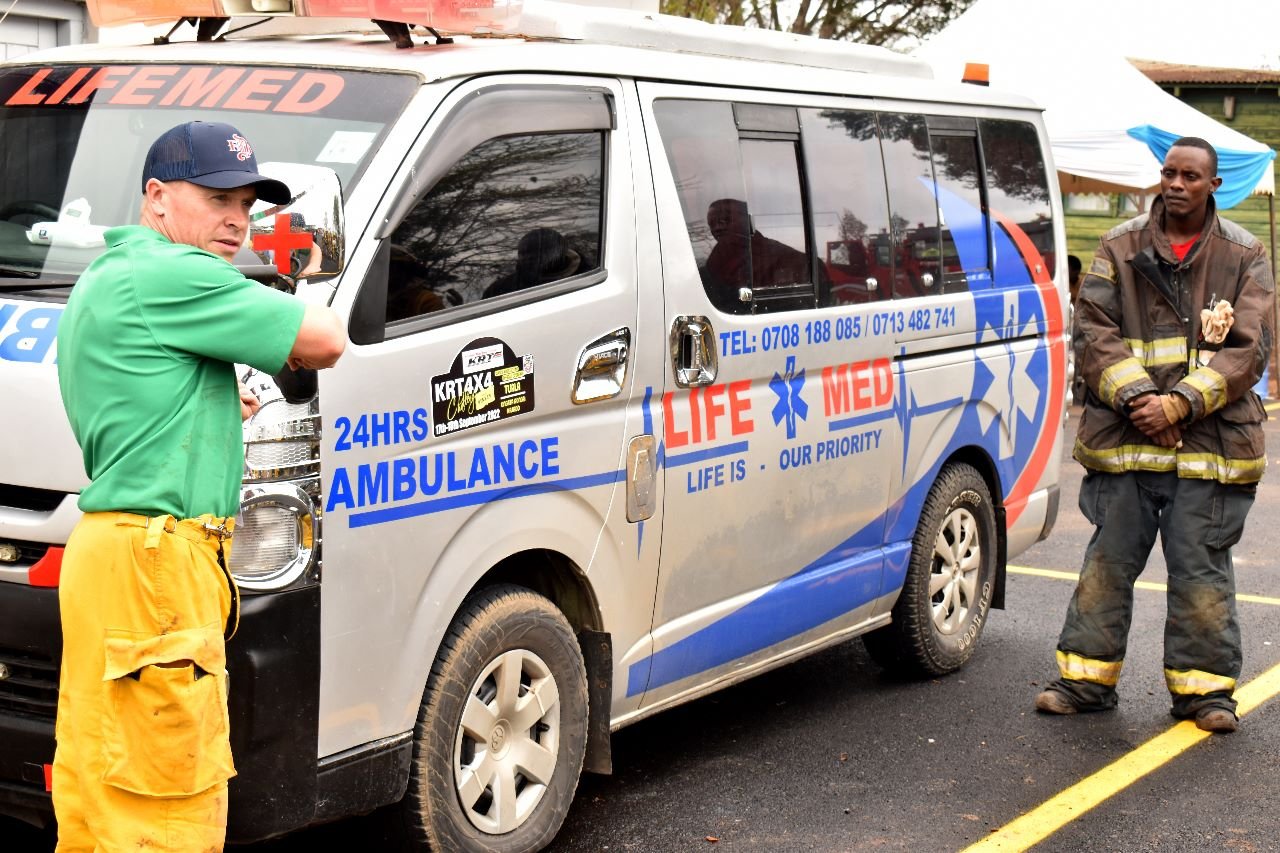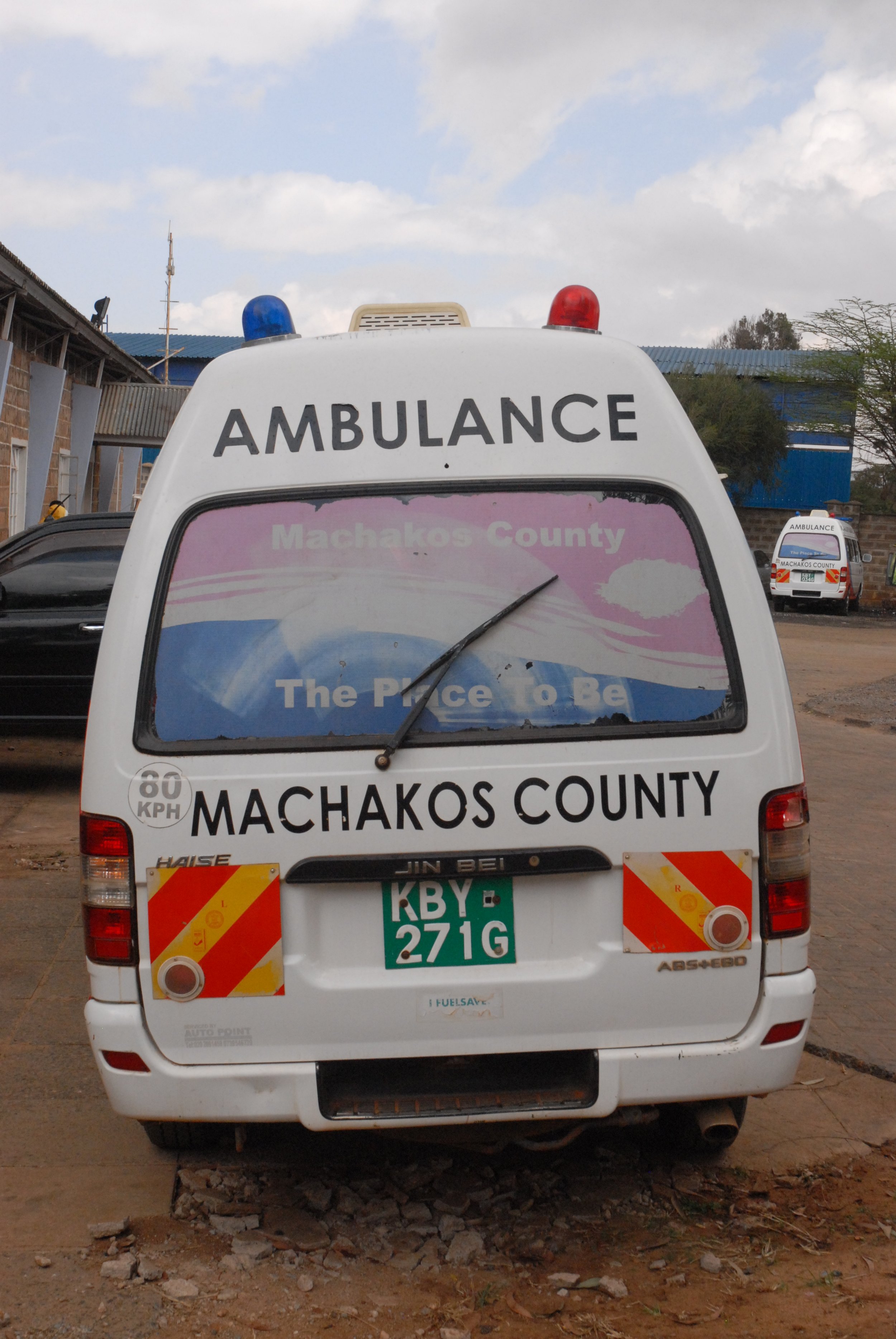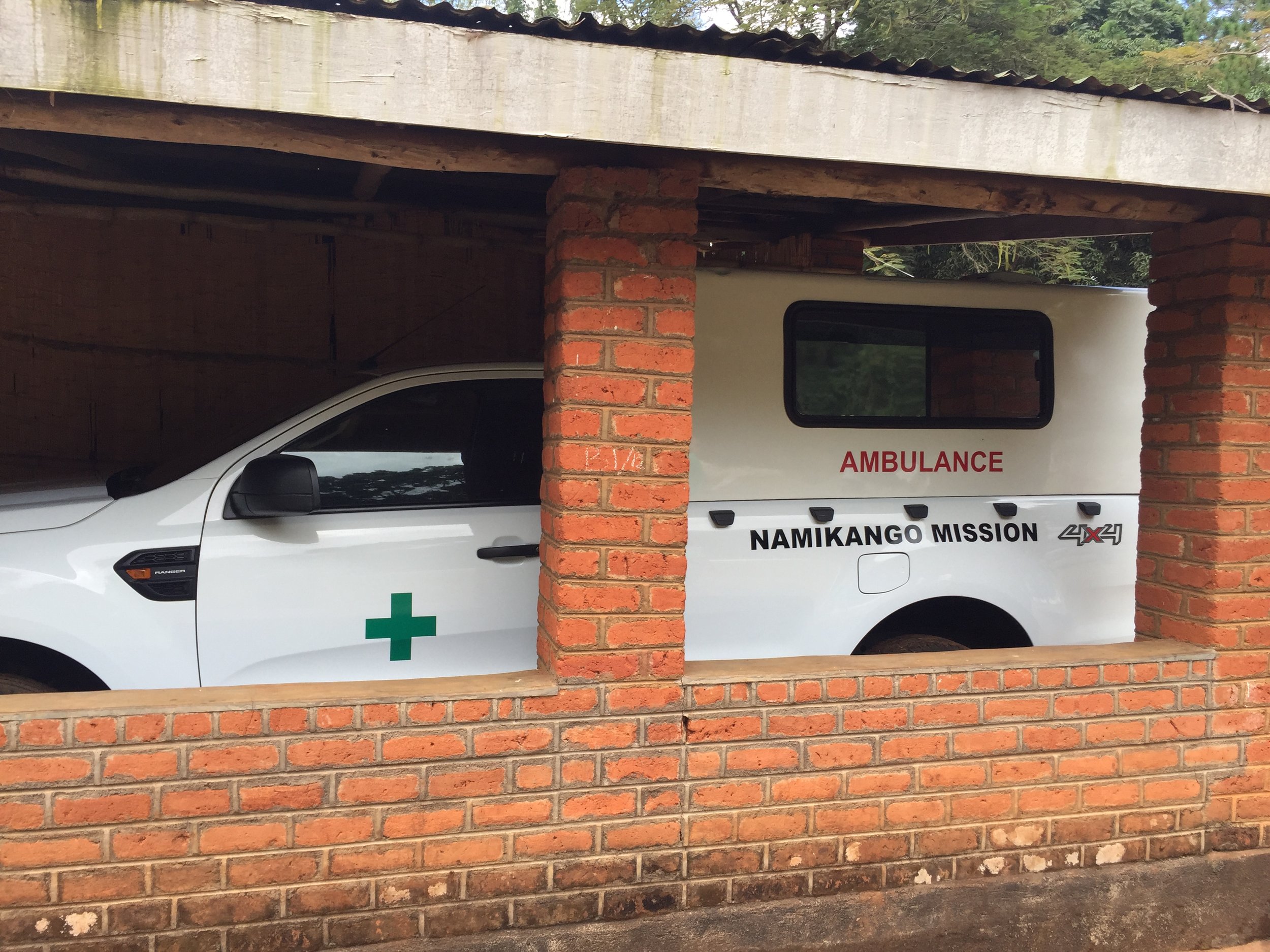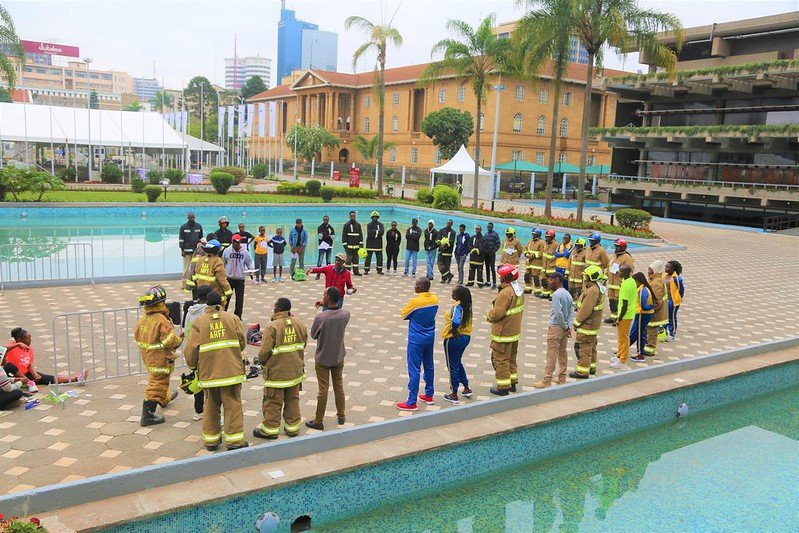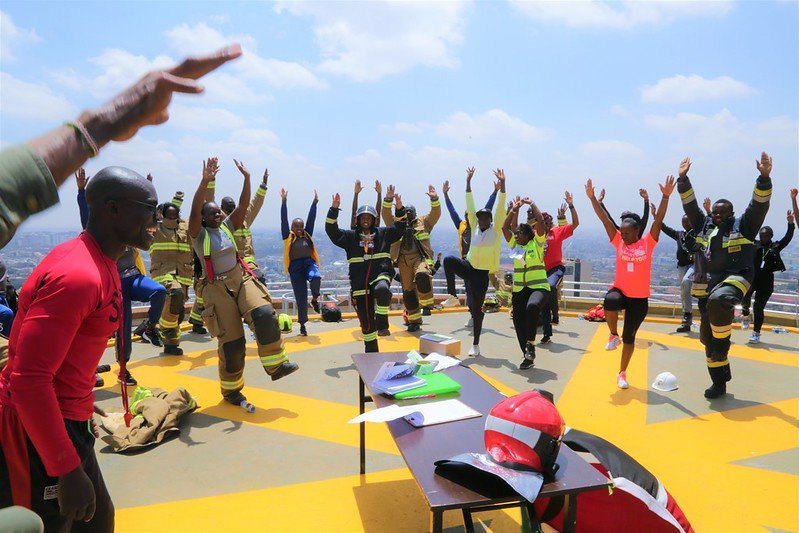In September 2024, members of the AFM team travelled to Kenya on a Mission Trip. The goal of this trip was to teach fire prevention lessons to children, teachers, and other community members across Nairobi, Kenya. In just ten days, over 20,000 individuals were taught potentially life-saving fire prevention lessons and tips.
2024 Chama Award Recipients: Mission Partner
Our partners are key to providing gear, volunteers, and logistical support to those we serve. We are so grateful for all the support we receive and would like to recognize a partner organization through our inaugural Mission Partner Award! This award recognizes a partner organization that makes significant contributions to AFM and, in turn, makes a substantial impact on the people that AFM serves.
2024 Chama Award Recipients: Volunteer and Instructor of the Year
Our volunteers and instructors assist with our programs, help unload and pack gear, and provide valuable training to firefighters in Africa. We are so grateful for all the support we receive and would like to recognize two of our supporters through our annual Volunteer and Instructor of the Year Awards! These awards were made to recognize individuals who make significant contributions to AFM and, in turn, make a substantial impact on the people that AFM serves.
AFM Receives Grant from the LION Foundation
Having a full-time employee in Africa has allowed AFM to connect with communities and pursue our mission in an exciting new way. Now, we are delighted to announce that LION has renewed its commitment to fire services in Africa and community fire prevention through a grant that will provide initial funding for us to employ an additional full-time Fire Safety Advocate in Africa!
Supporting Firefighters through PPE Donations
AFM is specifically looking for firefighter PPE such as coats, pants, hoods, helmets, boots, and gloves. Please check our Equipment Needs to see a full list of gear we can or cannot accept.
Press Release: AFM Receives Grant Award from the Laerdal Foundation for Stop the Bleed® Training Program
Africa Fire Mission (AFM) announces a grant award of $44,000 from the Laerdal Foundation for research to begin a Stop the Bleed® training program in Sub-Saharan Africa. The project will be led by Nancy Moore, MSW, LISW-S, Kirstin Henley, MD (Baylor College of Medicine), and Africa Fire Mission volunteers beginning November 2024 in Nairobi, Kenya.
Facing Electrical Issues
by Brad Banz
As firefighters, we respond to a wide variety of scenarios involving electrical hazards. Immediately, downed lines calls come to mind to most responders because of the obvious hazards they pose. In this article, I would like to discuss other types of incidents in which electrical hazards could be encountered and address our response as first responders.
Since I started the conversation by bringing up the topic of downed electrical lines, what should you do if you encounter such a situation? As in many other emergency situations, your job is to secure the area and keep people out. Electrical lines can carry many thousands of volts of electricity, with cross-country transmission lines carrying up to 345,000 volts. What does that mean to you? That means that you don't have to be in contact with the line for an electrical path to be established. Electricity from energized high voltage lines can jump several meters to things such as ladders if they are establishing a path to ground. The area around an energized downed line can also form a ground gradient, an area which is energized, and which will still be a shocking hazard. That's why it's important to secure the area in between poles and keep all ladders a minimum of 3 meters away from energized lines. Treat all lines as energized. Also have the contact number available for your local electrical utility so they can be notified of the situation. If electrical lines are downed across vehicles, have the passengers jump to become free from the vehicle if they can do so. If they cannot, then make them stay in the vehicle until the electrical lines have been shut off by the electrical utility.
Structure fires are another common instance when electricity can be an issue. While electrical service may not always be involved in the fire, regardless of cause, it's a good idea to secure electrical power to ensure that it doesn't become a hazard. Electrical power can usually be secured by turning it off at a circuit breaker if safe to do so. If electrical service is a major issue, the electrical utility must be notified so they can secure power outside the structure. The utility company should also be notified in areas such as informal settlements where illegal wiring arrangements are involved. The illegal wiring can be dangerous, especially with the iron sheet construction of many of these homes. Finally, one last consideration is hidden fire. If you have an electrical fire, or suspected electrical in wiring, open the wall up.
Many machines, especially in industrial settings, use lots of electrical power. Many times, an electrical fire or smoldering electrical fire can be controlled by simply securing electrical power to the machine. Even if the machine has any fire involvement at all not involving the electrical systems, it's still good to secure power. If power cannot be secured, a powder extinguisher suitable for electrical fires should be used. One set of machines in which powder should not be used on are computers or other types of electronics. Many computer centers have their own halon extinguishing systems. CO2 extinguishers are the preferred agent for use on computers and electronics.
While there are other electrical issues that you as a first responder may run across during your career, I tried to come up with the ones that you would be most likely to come across. I hope that everyone has gained something from this article. As always, stay safe out there.
Brad Banz has been involved in the fire
service for 40 years, serving with the Colwich
Fire Department as a volunteer from age 20,
including a 10 year term as Chief. Brad Banz
has served with AFM on several mission trips.
AFM Reengages with the Fire Service in Zambia
Making an Impact - Stories from Malawi 2024
Africa Fire Mission at the Inaugural World Fire Congress
From May 7-8, 2024, delegates from over fifty countries gathered in Washington, DC, USA for the inaugural World Fire Congress. This historic event was established by the US Fire Administration with many other partners to connect the fire service around the world and offer an opportunity to strengthen and empower firefighters and their communities. Members of the Africa Fire Mission team were present during the congress and helped to ensure that representatives from Africa were invited as delegates.
Africa Fire Mission at FDIC International 2024
Africa Fire Mission attended FDIC International this year! The Fire Department Instructors Conference is one of the largest firefighting conferences in the world and it gave our team members a great opportunity to network with members of the fire service community. Our team had a busy week connecting with organizations and collecting gear donations. We’re grateful for all the wonderful people we were able to connect with!
The First Five Minutes
The First Five Minutes
by Mark van der Feyst
Every day in North America, fire departments are responding to structure fires that involve residential buildings. The bulk of the workload for the fire department will be the residential home as statistics show that every 86 seconds a fire department is responding to a residential fire. Once a fire department arrives on scene, they need to act quickly as the number one priority on the fire scene is life safety. This involves the occupants inside the residential building as well as the responding personnel. In 2014, there were 2,860 civilian fire deaths attributed to a structure fire.
The time a fire department’s first arriving officer and crew have to affectively size up situation and decide on what action to take in order to address the life safety priority is less than 2 minutes. Within that timeframe, many factors need to be considered, evaluated, processed and then decided upon based upon priorities. The first five minutes are crucial to any fire ground operation and sets the tone for the remainder of the call – it will either set the tone for a successful outcome or it will set the tone for a not so favourable outcome.
Studies have shown that fire grows at a rate that doubles in size every minute. Modern fuel loads and heat release rates add to the fire’s intensity. Every minute that we are indecisive on scene is another minute of rapid-fire growth. By using information gathered during pre-planning and from Dispatch updates, coupled with situational awareness and a strong size-up, the Incident Commander should be able to formulate tactical decisions that have positive influence on truck placement and task assignments taking into consideration manpower issues that face many smaller departments.
The First Five Minutes starts with how to correctly size-up an incident scene, and then how to get the information clearly and concisely to incoming units and Dispatch. As we all know, size up begins when the call comes in and ends when all are back at the station. How can we prepare ourselves ahead of time so that our size up will be streamlined and efficient when arriving? We can do this by sizing up our response districts during our down time or when we are driving around in our response areas. By observing the present clues that are in front of us on a daily basis, we can build a data bank within our minds of what we know exists within our boundaries.
One such area is knowing your response district and the types of residential buildings that comprise it. Knowing the common construction types, the common layouts, the average age of the homes and so on will help with creating different rescue profiles. By having these different profiles, the firefighter and company officer can gauge ahead of time what exactly they are dealing with and when the call comes in, they will have a better understanding of where they are going to and what they are getting into.
Another factor that can be added into the equation of knowing the area is with the demographics. Knowing who in terms of average age, in terms of type of population such as seniors or retirement type of people or maybe students will help with creating a rescue profile. This can be accomplished by searching for this information from local government or from just observing the response district.
Other aspects of the size up is with knowing common locations of where fire victims are found within the residential structure. They are usually found in exit areas such as windows, doors, top of stairs, bottom of stairs, middle of stairs, and in the hallways, at the fire location or in their beds depending upon the time of day. Knowing these common locations helps with the effective rescue and where to begin the search or which tactic to use.
The fire apparatus is another area that can be addressed for the first five minutes. One focal point is with the equipment options available to the membership. This involves setting up the apparatus for quick and easy access of required hand tools for any rescue operation. This involves utilizing compartment space effectively and placing certain tools on the right side of the apparatus.
Along with this is the aspect of combat ready tools. This is where the fire department can have certain tool combinations pre-made or pre-arranged and then placed in a spot on the apparatus that will be sensible and quickly grabbed. Such examples may be the hailgan and the axe, the haligan and the roof hook, the haligan and the maul, or the hailgan and the water can. There are many different tool variations that can be pre-arranged ahead of time.
Having pre-arranged seating assignments is also a good idea to quicken the rescue operation. This is where no matter who sits in what certain seat in the back or the front of the apparatus, they have a specified job function that is standard. This cuts down the time and decision making ability on who will do what – instead allowing firefighters to react based upon their assigned function.
One last area that can be looked at is our tactical options. There are many tactical options that are available for any one fire department to use – it is just a matter of using the right one for the right situation and being efficient with it. Tactics starts with training and becoming familiar with how they are beneficial, the reasons why they are different from each other and how they can be incorporated into the department’s operational capabilities.
Tactical options include things such as VES or VEIS, PPA, tactical ventilation, transitional attack, offensive attack, defensive attack, fast attack, blitz attacks, all hands rescue and so on. Tactics are a great tool for the firefighter and enable them to be effective on the fire ground – but only work when they are trained on time and time again. The place to use a tactic for the first time is not on the fire ground, it is to be used for the first time on the training ground.
By focusing upon these areas and others such as communications, the culture of the department, rescue plans and SOG’s and SOP’s, the fire department can be effective within the first five minutes.
Mark van der Feyst has been in the fire service since 1999 working in both Canada and the USA. Currently he works for the Fort Gratiot Fire Department in Michigan after taking early retirement from his career department at the end of 2020. He is an international instructor teaching in Canada, USA, India and many large and regional conferences such as FDIC, Firehouse World & Expo. He holds an MS in Safety, Security & Emergency Management from Eastern Kentucky University and has been providing virtual training sessions for Africa Fire Mission for two years.
Serving In Nigeria with FCT Fire Service and IHVN
It was great to be back in Abuja, Nigeria in January and early February!
An AFM team of six provided training to FCT firefighters, IHVN staff and partners from the “Committee of Stakeholders on the General Safety & Security of Cadastral Zone C00 Abuja FCT.” The training allowed the AFM team to assess the capabilities of the firefighters as well as gain a better understanding of the community’s perspective of firefighters. Training for the FCT Fire Service focused on enhancing fire response capabilities, promoting utilization of available equipment and tools for firefighting, and enhancing community awareness.
Team member Mike Kull elaborated that “we were able to provide quality training on a wide variety of topics - Breathing Apparatus, Ladders, Hose Drills - Firefighters from FCT Fire Service were eager to learn and we expect to see rapid and positive results from this training. We realize that development is a slow process but we have high hopes for the firefighters here in Nigeria.”
Head of Operations, FCT Fire Service, Engr. Adesina Abioye, stated that the training has updated Fire Service Staff with modern professional ways of rescue and firefighting, and served as a refresher course on fire prevention and administration for the Senior Staff who participated. “The importance of the partnership cannot be overemphasized; it has brought tremendous benefits to the partners and the stakeholders community. What would have cost the FCT administration a huge sum of money was made available at no cost due to partnership,” he said.
AFM also conducted a needs assessment to identify tools and equipment needed to further develop the FCT Fire Service and donated firefighting equipment. This equipment included firefighting coats, boots, gloves, suspenders and helmets for enhanced effectiveness in responding to fire incidents and saving lives, property, and critical infrastructure.
We are grateful that IHVN is committed to collaborating with FCT Fire Service to enhance the capabilities of the fire service and look forward to continued collaboration in Nigeria.
The Five C’s of Radio Communications
The Five C’s of Radio Communications
by Mark van der Feyst
The essential elements of effective incident scene communications fall into five categories. Understanding these attributes of successful communication and engaging in the suggested strategies will enhance your communication effectiveness, as well as that of the overall communications on the emergency incident scene. These are known as the Five C’s of Radio Communications: Conciseness, Clarity, Confidence, Control and Capability.
Conciseness
· Keep the messages short and concise. This will help in reducing radio traffic.
· Keep the messages specific. Think about what you want to say before you speak and then say it.
· Condense the message as much as you can while still keeping it complete. This will help in eliminating any confusion by the receiver.
Clarity
· Use standard terms as defined in your department’s procedures. This will avoid any confusion on the incident scene.
· Use plain-text language in all radio communications. Avoid using ten-codes, acronyms, or technical jargon.
· Avoid multitasking. Describe and assign one task at a time to company members. Do not overload a company with multiple tasks to be completed at one time.
Confidence
· Communicate on the radio in a calm manner. This helps to maintain calmness on the incident scene and does not create or add to hysteria.
· Be audibly received. Speak in a voice loud enough to be heard by the receiver. Do not speak in soft tones or yell into the radio. Yelling will distort the message, whereas speaking too softly will require repeating of messages.
· Use a good vocal pitch to communicate. This will help to be audibly received. Having a high pitch or a low pitch will have the same impacts as in the previous point.
Control
· Take control of the radio communications on the incident scene. Follow established departmental procedures and protocols.
· Minimize unnecessary radio chatter. Prioritize messages to be sent and received.
· Keep your emotions in check. This will help with establishing confidence and allow for more sensible direction to be given.
Capability
· Use active listening skills. Be sure to hear all the messages that are being transmitted to you. This may require being in a quiet place versus being outside near a working engine.
· Know how to use the communications equipment. Know where to hold the radio or microphone in relation to your mouth, SCBA face piece, or other radios nearby that may produce feedback.
about the author: Mark van der Feyst has been in the fire service since 1999 working in both Canada and the USA. Currently he works for the Fort Gratiot Fire Department in Michigan after taking early retirement from his career department at the end of 2020. He is an international instructor teaching in Canada, USA, India and many large and regional conferences such as FDIC, Firehouse World & Expo. He holds an MS in Safety, Security & Emergency Management from Eastern Kentucky University and has been providing virtual training sessions for Africa Fire Mission for two years.
Successes of 2023 and Opportunities for growth in 2024
December 2023 -
WOW! It’s been a busy year for Africa Fire Mission and every week we get requests to serve in new places!
Here are some highlights of the work you’ve supported this year -
· Team mission trips to Kenya & Malawi with more than 40 instructors!
· Tochi and Jose Fire Safety Show airing daily on TV in Kenya with new episodes planned for early 2024!
· Replication of Community Fire Prevention efforts with more than 30 African volunteers providing fire safety training to their communities.
· Weekly firefighter refresher training for 150 people online each week!
· 500 sets of firefighter PPE donated to fire departments in Africa (Kenya, Malawi and Nigeria).
We need your help to continue to grow our impact - Would you consider making a year-end gift support our work in 2024? Your ongoing support allows us to continue to serve firefighters across Africa! By volunteering with us, praying for us and supporting our work financially, you are part of our team and our success!
Thank you for saving lives through fire departments and communities in Africa. We appreciate your generous support and partnership!
Wishing you a blessed Christmas and Holiday Season,
Nancy L. Moore,
Co-Founder & Executive Director
Africa Fire Mission Receives Major Grant from Motorola Solutions Foundation
October 17, 2023
Africa Fire Mission Receives Major Grant from Motorola Solutions Foundation
Africa Fire Mission (AFM) is a Cincinnati-based non-profit organization with team members of firefighters, chief fire officers and other first responders from across the United States, Canada and Europe. For eleven years, AFM has provided fire training and equipment in various parts of Africa. AFM has announced they have received a $25,000 grant from the Motorola Solutions Foundation, the charitable arm of Motorola Foundation, to help continue its training programs and to provide a national Fire and EMS Training Symposium and Competition in Kenya in November 2023.
This grant will support hands-on Fire Training and distribution of firefighter personal protective equipment (PPE). In November, a team of thirty-five firefighters, EMT’s paramedics and other professionals from the United States will train over 500 Kenyan firefighters and EMT’s at the Jomo-Kenyatta International Airport in Nairobi, Kenya.
AFM’s training team members volunteer their time and pay their own expenses to travel to Africa to teach their fellow firefighters the latest techniques in firefighting, rescue and emergency medical services.
“Africa Fire Mission is grateful to Motorola Solutions Foundations for its continued support of our programs through this grant. It is because of dedicated volunteers and partners like Motorola Solutions Foundation that we are able to continue to impact communities and support firefighters in Africa as they strive to save lives and property” says Nancy Moore, Executive Director for Africa Fire Mission.
The Motorola Solutions Foundation, which has donated $100 million over the past 10 years, focuses its giving on three key areas: First responder programming, technology and engineering education, and programs that blend the two. The Foundation has a long-standing commitment to supporting programs that benefit underrepresented populations and aims to partner with organizations that align to its values of accountability, innovation, impact, diversity and inclusion.
"The Motorola Solutions Foundation is honored to partner with organizations like Africa Fire Mission that are actively driving positive change within the community," said Karem Pérez, vice president of Diversity, Equity and Inclusion and executive director of the Motorola Solutions Foundation. "We are immensely proud of the work that Africa Fire Mission is doing, and we look forward to seeing their continued impact."
For additional information on the Motorola Solutions Foundation grants program, visit: motorolasolutions.com/foundation-grant-partner.
For additional information regarding Africa Fire Mission visit: www.africafiremission.org - Contact Nancy Moore at 513-620-4236 or nancy@africafiremission.org
About Africa Fire Mission
Africa Fire Mission is a nonprofit organization committed to increasing the sustainable capacity of Fire Departments in developing communities. We accomplish this through training, empowerment, support and encouragement.
Train – We partner with governments, NGO’s, missionaries, schools and corporations to provide education and training to firefighters and local communities. We use Community Health Education to teach firefighters and community members in Africa to protect themselves from the dangers of fire. We provide fire prevention training and fire safety assessments to schools ensuring the students are able to learn in an environment safe from fires.
Empower – We work to increase the ability of communities in Africa to respond to disasters and provide relief when disasters occur.
Support – We provide personal protective equipment and communication tools to fire services throughout Africa to allow fire departments to operate in a safer and more coordinator manner.
Encourage – We build the capacity of African fire services so that local communities are able to provide sustainable public safety and disaster management services.
Where does AFM work?
Africa Fire Mission currently works throughout Africa including: Nigeria, Kenya, Malawi, and Zambia.
About the Motorola Solutions Foundation
As the charitable and philanthropic arm of Motorola Solutions, the Motorola Solutions Foundation partners with organizations around the globe to create safer cities and equitable, thriving communities. We focus on giving back through strategic grants, employee volunteerism and other community investment initiatives. Our strategic grants program supports organizations that offer first responder programming and technology and engineering education, and align to our values of accountability, innovation, impact, diversity and inclusion. The Foundation is one of the many ways in which the company lives out its purpose of helping people be their best in the moments that matter. For more information on the Foundation, visit: www.motorolasolutions.com/foundation
Why should fire trucks and ambulances always show up for a medical emergency?
Why should fire trucks and ambulances always show up for a medical emergency?
By Kelvin from Swift Emergencies Response Unit - Kenya
When a call comes in at the call center, dispatchers often are not given precise or complete information. As such, units are dispatched on a worst-case scenario. To ensure the highest level of care, the closest fire engine station is dispatched and EMS sends an ambulance (staffed with two paramedics and/or EMT's).
No medical call is “routine.” Most require assessing the patient, obtaining their vital signs, providing oxygen therapy, and moving them, at a minimum. EMS may also need to place an advanced airway, administer drugs intravenously, or monitor cardiac conditions. All of these procedures are completed more efficiently when the appropriate amount of help is on scene. Efficient care is our goal, and efficient care often is the difference between life and death.
Unfortunately, units have no way of knowing what they will encounter on a call until they arrive. They work in a “what if” and “all risk” business. Responding to the unknown is public safety. The public can help by calling emergency numbers quickly when there is an emergency and providing details of the emergency. Emergency hotlines are your instant go-to when the need arises. It is important that you know the numbers to call to get assistance and keep a copy with you.
Celebrating our Volunteers!
On October 14, 2023 during our Annual Fundraiser, the Chama, Africa Fire Mission will honor volunteers Chief Bradley Banz and Chief Michael Kull.
Volunteer of the Year
Africa Fire Mission thrives on volunteers. Volunteers are at the heart of our organization. We have dozens and dozens of volunteers. We have volunteers from all across the North America, Africa and Europe that help allow AFM to serve on a daily basis. These men, women, firefighters, civilians and children are all a vital part of Africa Fire Mission being able to achieve its goals and objectives.
Chief Michael Kull – Volunteer of the Year
Chief Mike first joined Africa Fire Mission team in 2021 and has been all in with us ever since. Mike has participated in missions to Kenya and Malawi and facilitates AFM’s weekly virtual trainings. This past year, Mike stepped further into leadership co-leading our Malawi training trip! Mike just get’s it. He understands that the fire service in Africa is limited in physical resources and rich in people resources! Mike uses his creativity to help solve problems and helps the fire service advocate for what they need. This week we learned that the Zomba, Malawi fire brigade received its first uniforms from their local government as a result of the advocacy that their team learned from Mike. Mike’s dedication to facilitating our online trainings and lead to steady growth of our trainings from 60 participants a week at the beginning of 2023 to more than 100 participants a week now.
Mike fully embodies our mission to train, empower, support and encourage firefighters in Africa and his leadership has allowed us to continue to grow!
Thank you Mike for all that you have done for Africa Fire Mission! We are looking forward to serving with you for year’s to come!!
More about Chief Michael Kull: Chief Michael Kull is from Pennsylvania where he recently retired as the Fire Chief for the Valley Township Fire Department, Forest Fire Warden for Weiser State Forest and as a Township Supervisor for Valley Township. As a volunteer firefighter with over 25 years of experience, Michael has learned creative strategies for meeting his community’s needs for fire and rescue services.
Instructor of the Year
When Africa Fire Mission travels with a team to provide training in Africa or other parts of the world, our team members volunteer their time, talents and treasures to provide world class training to our partners. Our instructors undergo training in advance of the trip to prepare of the mission and prepare the lessons that they will teach in our week long fire training events. We are fortunate to have many instructors return year after year who continue to build each year on the training that they have been providing as well as to build strong relationships with firefighers and our overseas partners.
Chief Bradley Banz, Instructor of the Year
Chief Banz heard about AFM from our partner at Missions Of Hope International after providing CPR and first aid training there. Brad’s been involved with AFM since 2015. Brad has traveled with AFM on missions to Kenya, Zambia, and Malawi. Brad has been instrumental in the development of our Community Health Evangelism curriculum on Fire Prevention and Safety which has impacted millions of lives across Africa. Brad notices needs and responds making sure that curriculum developed for classes he teaches meet the needs of the fire service. This past year, he developed a Hazardous Materials class for firefighters in Africa after seeing the dangers firefighters were exposing themselves to attempting to respond to some Haz Mat incidents.
Brad encourages our team members and advocates for the firefighters. He takes time to get to know the firefighters we are serving and what their needs are. His heart for Africa is abundantly clear!
Thank you Brad for serving with heart and passion! We are grateful to have you on our team!
More about Chief Bradley Banz: Chief Banz is a firefighter with over 38 years of experience. Brad retired as a Captain for the Wichita, Kansas Fire Department and retired as Fire Chief from Colwich Kansas. Brad continues to serve his community as a volunteer firefighter in addition to training firefighters in Africa.
Interested in volunteering with AFM in administrative roles or as one of our international instructors?
Ambulance Services and Its Importance in Society
Ambulance Services and Its Importance in Society
By: Kelvin from Swift Emergencies Response Unit - Kenya
Increase in medical ailments has led to the rise in hospitals and emergency medical services assisting patients who require emergency medical assistance at critical moments, helping them to reach the hospital on time thus saving their life.
Private and public ambulance transport services are operating in more numbers today as an inevitable service providing care to critical patients at crucial moments. In Kenya, ambulance operating centers are set up at every hospital and private EMS organization. These Ambulance operating centers function with adequate ambulance transport services to offer immediate medical care for patients. Private ambulance transport services depict a consistent rise in the growth curve each year offering non-emergency services unlike hospital ambulance transport services which primarily function for emergency needs. Some of the non-emergency services include shifting patients from one hospital to another, transporting patients for any scanning or laboratory services to the relevant facilities, or patients with any travelling disabilities in normal vehicles to hospitals for treatments.
Emergency ambulance services are usually equipped with adequate medical equipment and paramedical professionals. Sometimes, non-emergency ambulance transport services are also equipped with some basic medical aids and a para medical staff to cater the needs of immediate medical care to patients.
Let us discuss a few points about the pre-hospital medical professions - paramedics and emergency medical technicians (EMTs) who are the spine of ambulance transport services:
Paramedics or EMTs are first treating patients even before doctors (pre-hospital care) thus saving patients through immediate medical procedures ensuring the vitals stable before reaching hospitals for further treatments.
Paramedics and EMTs are trained healthcare professionals, authorized to attend patients with required medications and procedures based on their training level.
Education level, standards, functions and skills of paramedics and EMTs vary with countries. However. certain standard functionalities remain common such as being trained to practice CPR procedures for cardiac arrest patients, usage of defibrillators, certain analgesic, paralytics and sedative medications for pain control, first aid to treat burns, fractures, childbirth complications, spine injury, airway management, blood control etc.
One should respect the noble service of prehospital providers who form an integral part of ambulance services.
The youth of our nation should involve themselves in such noble service, joining community life saving teams and can considering a career as a paramedic or EMT.
The government could benefit from taking initiatives to support volunteer community first responders at the community level and to empower them to continue saving lives at the scene before qualified personnel arrives.
Kenya Stairclimb 2023
Kenya Stairclimb 2023
On September 16, 2023, firefighters gathered for a day of remembrance of fallen firefighters and a day of camaraderie and awareness of the fire service in Kenya.
Heels on Mountains collaborated with Africa Fire Mission for this year’s Annual Firefighter Stairclimb event in Kenya, which had a had a total of 65 participants! We are grateful to all the participants and sponsors of this event.
Heels on Mountains has continuously supported firefighters in Kenya since 2019, supporting 4 stairclimb events for firefighters at the Kenya International Conference Center . Thank you to everyone that participated: Mombasa County, Kenya Airports Authority, ICT Fire and Rescue, West Pokot County. We are grateful to individual Firefighters and EMT’s as well as supporters of First Responders.
Asanti sana. You helped Kenya be on the map as the only African country that commemorated the Twin Tower bombings with a stair climb activity.
Check out photos from the Kenya Stairclimb event here:

